

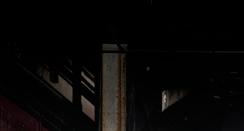
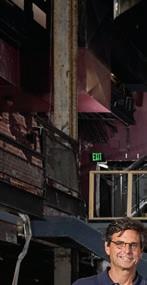






























Here When You Need



























































































































53 Little Betsy Poem
54 Writers of Passage
Faux-bituaries from our very much alive-and-well community
58 Ghost Town By Cynthia Adams
Apparations in the area
62 Strolling with Fungi By Ross Howell Jr.
A woodland garden flourishes in an old Winston-Salem neighborhood
68 What's Old is Nu Again By Page Leggett
Former Double Oaks owners’ new project
72 Welcome to the Neighborhood By Maria Johnson
Terry Christian's barndominium houses creatures great and small
83 Almanac By Ashley Walshe

gessner









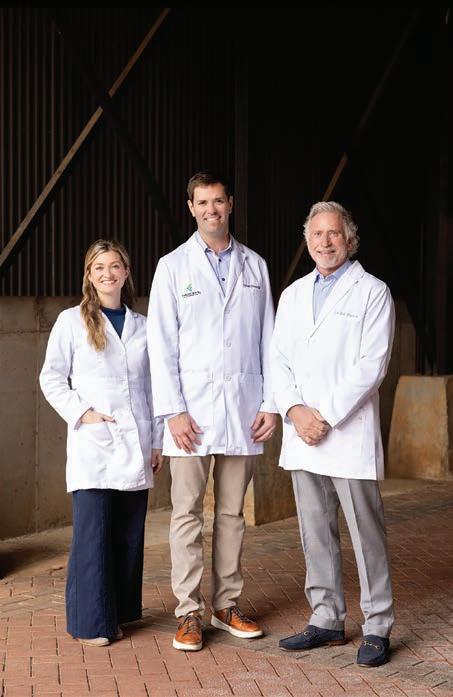


MAGAZINE
volume 15, no. 10
“I have a fancy that every city has a voice.” www.ohenrymag.com
PUBLISHER
David Woronoff david@thepilot.com
Andie Rose, Creative Director andiesouthernpines@gmail.com
Cassie Bustamante, Editor cassie@ohenrymag.com
Jim Dodson, Editor at Large jwdauthor@gmail.com
Keith Borshak, Senior Designer
CONTRIBUTING EDITORS
Cynthia Adams, David Claude Bailey, Maria Johnson
CONTRIBUTING PHOTOGRAPHERS
Betsy Blake, Lynn Donovan, Amy Freeman, John Gessner, Bert VanderVeen, Mark Wagoner
CONTRIBUTORS
Harry Blair, Anne Blythe, Susan Campbell, Jasmine Comer, Ross Howell Jr., Billy Ingram, Page Leggett, Tom Maxwell, Gerry O’Neill, Liza Roberts, Stephen E. Smith, Sarah Ross Thompson, Zora Stellanova, Ashley Walshe, Amberly Glitz Weber
ADVERTISING SALES
Lisa Allen
336.210.6921 • lisa@ohenrymag.com
Amy Grove
336.456.0827 • amy@ohenrymag.com
Brad Beard, Graphic Designer
Jennifer Bunting, Advertising Coordinator ohenrymag@ohenrymag.com
Henry Hogan, Finance Director 910.693.2497
Darlene Stark, Subscriptions & Circulation Director 910.693.2488
OWNERS
Jack Andrews, Frank Daniels III, David Woronoff
In memoriam Frank Daniels Jr.
©
O.Henry











Cone Health Steven D. Bell Family Heart & Vascular Center Is Now Open.

conehealth.com/heart

by Cassie bustamante
Signs are everywhere, if only we pay attention. Too fixated on where we are going and knocking out miles-long to-do lists, we often miss them. But, in my case, sometimes the universe gives me a little auditory nudge — a snap of its fingers, so to speak — before showing me the sign I need. Four years ago, it was a song.
I am driving south on Church Street with my teenage daughter, Emmy, riding shotgun on a clear, crisp day. We’re on our way home from Sunset Market Gardens, where I’ve loaded up on veggies, greens and eggs for the week. One of the perks to running errands with Mom, especially early morning weekend ones? Control of the music. Her playlist of every song ever released by Taylor Swift shuffles through the car speakers. When “Marjorie” comes on, Emmy casts me a sideways glance and offers a gentle smile, knowing that when I hear it, I think of Sarah, my best friend and former business partner who’s just passed away.
If I didn’t know better
I’d think you were still around
What died didn’t stay dead
What died didn’t stay dead
You’re alive, you’re alive in my head
Just then, in an all-but-blue sky punctuated by a cloud or two, a rainbow appears. No sign of rain anywhere, yet there it is in its vivid ribbons of color. Emmy and I both gasp.
Two years later, I’ve just ended an exhausting month. My husband, Chris, has traveled three out of four weeks, while my kindergartener, Wilder, and I have both been sick. There’s only so much rage-vacuuming my house can take. Of course, with three kids and two dogs, the house isn’t actually clean, but the loud hum of the vacuum drowns out the noise nicely. I’ve heard it said that being an adult is a constant loop of saying “I just have to get through this week.” By that measure, I should be very grown up by now, though the jury’s still out.
Thanks to antibiotics, Wilder heads back to school and I’ve got a day to catch up on writing. Settled in at my favorite writing desk, the kitchen table, I tap away at my keyboard while a cool breeze blows through the open windows. Happy with my progress, I gift myself a little brain-break and mindlessly open up Facebook. A “memory” reminds me that today is the anniversary of Sarahs’s death. Immediately, a wash of shame spreads from my cheeks all the way to my toes. How could I have forgotten?
My eyes dart upward, to a place where I imagine Sarah can hear me. “I’m so sorry,” I whisper.
Not a moment later, before I even have time to pause to await a reply, I hear the familiar jingle of a dog’s collar. My own two pups are safely curled up on our leather sofa, but I peer onto our lawn and spy a dog I don’t recognize moseying around, no owner in sight.
Ugh, I don’t have time for this right now, I think. But I consider how I’d feel if my own dog was out there loose. Plus, I am a bit of a softie. In fact, when I became pregnant with our first child 19 years ago, Chris, worried I might put myself and the baby in danger, had to tell me to stop bringing home strays. But this shaggy, golden-amber dog looks innocent enough.
I step off my porch. “Hi, puppy.”
She saunters over slowly, tongue lagging out the side of her mouth, as I reach down to scratch behind her ears and catch a glimpse of the purple bone-shaped tag engraved with her name.
“Brownie,” I say, “aren’t you a sweet girl?” She rolls gently onto her back, inviting a belly rub.
I locate the tag with the owner’s number, and dial. The phone begins to ring and just before the owner answers, I catch the name on the tag so I know how to address her: Sarah.
I can’t believe it. And yet I can.
Sarah, the dog owner, and Brownie reunite with licks and snuggles on my front lawn as I look to the sky, where I imagine my friend smiling down at me.
It’s been four years since her death. Like waves of grief, the signs don’t stop coming, but have lessened, more time passing between each. And now, when I notice them, I don’t cry anymore. I smile, grateful in the knowledge that Sarah is still around. OH
Cassie Bustamante is editor of O.Henry magazine.
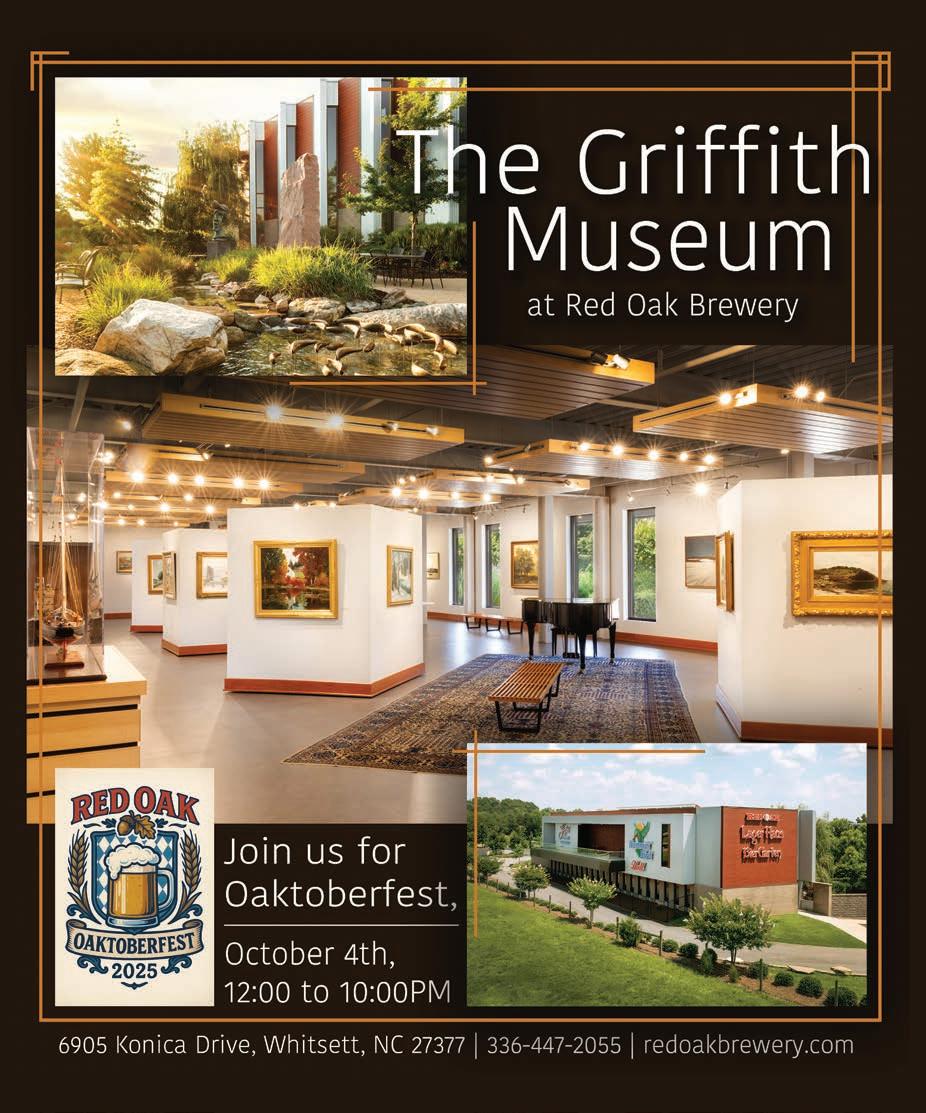

Recognized as a Castle Connolly Top Doctor, Dr. Edw ard Gronet, Board-Certified Plastic Surgeon, exemplifies excell ence in patient care and results. At H/K/B, our mission is to elevate the standard of aesthetics by seamlessly blending advan ced plastic surgery with the latest MedSpa treatments. This sea son, restore balance and refresh your skin with rejuvenating ser vices designed to smooth, tighten, and enhance your natur al beauty— leaving you radiant through every season.
Dr. Edward Gronet
PA-C



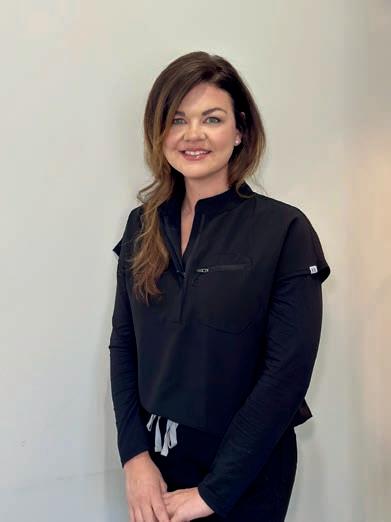





by Jim dodson
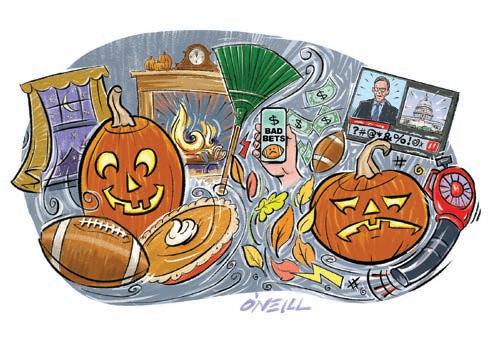
My late mother liked to tell how, once upon a time, I loved to stand at the fence of the community-owned pasture behind our house in North Dallas feeding prairie grass to a donkey named Oscar.
I was barely walking and talking.
“You weren’t much of a talker, but seemed to have a lot to say to Oscar, far more than to anyone else,” she would add with a laugh. “We always wondered what you two were talking about.”
Oscar’s kind, old face, in fact, is my first memory. Though I have no idea what “we” were talking about, I do have a pretty good hunch.
My mom also liked to tell me stories about growing up in the deep snows of Western Maryland, which sounded like something from a Hans Brinker tale, fueling my hope to someday see the real stuff. Quite possibly, I was asking Oscar if it ever snowed in Texas.
I finally got my wish when we visited my mom’s wintery German clan for Christmas, days after a major snowstorm. It was love at first snowball fight with my crazy Kessell cousins. We spent that week sledding down Braddock Mountain and building an igloo in my Aunt Fanny’s backyard in LaVale. I hardly came indoors. I was in snowy heaven.
My mom took notice. “You’re such a kid of winter,” she told me. “Maybe someday you will live in snow country.”
Her lips to God’s ears.
Twenty years later, I moved to a forested hill on the coast of Maine where the snows were deep and winters long. My idea of the perfect winter day was a long walk with the dogs through the forest after a big snowstorm, followed by supper near the fire and silly bedtime tales I made up about our woodland neighbors as I tucked my young ones into bed. On many arctic nights, I lugged a 50-pound bag of sorghum to a spot at the edge of the
woods where a family of white-tailed deer and other residents of the forest gathered to feed. Tramping back to the house through knee-deep snow, I often paused to look up at the dazzling winter stars that never failed to make me glad I was alive.
Perhaps this explains why I love winter as much as my wife does summer.
The good news is that we find our meteorological balance come October, a month that provides the last vestiges of summer’s warmth even as it announces the coming of winter with shorter days and sharply cooler afternoons. We share the pleasure of October’s many comforts.
As Wendy can confirm, her baking business ramps up dramatically in October as customers at the weekend farmers market clamor for her ginger scones, carrot cake and popular seasonal pies — pumpkin, pecan and especially roasted apple crumb — which typically sell out long before the market closes at noon. October marks the beginning of her busiest and happiest baking season.
Meanwhile, back home in the garden, I will be joyfully cutting down the last of the wilted hydrangeas, cleaning out overgrown perennial beds, spreading mulch on young plants and already planning next summer’s garden adventures — that is, when I’m not raking up piles of falling leaves, a timeless task I generally find rather pleasing until the noise of industrial-strength leaf blowers fire up around the neighborhood.
Their infernal racket can shatter the peace of an October morn and make this aging English major resort to bad poetry, with apologies to Robert Frost:
I shall be telling this with a sigh two roads diverged in a yellow wood and I one weary gardener stood and took the path less traveled by with rake in hand and shake of fist oh, how these blowers leave me pissed!
With the air conditioning shut off and the furnace yet to fire
up, on the other hand, October brings with it the best time of the year to fling open bedroom windows and sleep like footsore pilgrims at journey’s end. At least our three dogs seem to think so. Our pricey, new, king-sized marital bed begins to feel like a crowded elevator on chilly October nights.
Among October’s other comforts are clearer skies, golden afternoon light and the first log fire of the season, celebrated by a wee dram with friends and thoughtful conversation that drifts well into the night until the host falls asleep in his favorite chair. That would be me.
Everything from my mood to my golf game, in fact, improves with the arrival of October. And even though my interest in all sports seems to dim a little bit more with each passing year (and the worrying growth of online betting), the World Series and college football can still revive my waning boyhood attention on a brisk October weekend.
Halloween, of course, is the grand finale of October’s comforts. What’s scary is how much money Americans shell out annually on costumes, candy and creepy, inflated yard decorations (something like $11.6 billion last year, according to LendingTree), which suggests to me that being happily frightened by the sight of lighted ghouls on the lawn and kids who come in search of candy dressed as the walking dead is simply a welcome break from the daily horrors of cable news.
Our Halloween routine is one I cherish. Wendy’s elaborately

decorated Halloween cookies disappear as fast as she can make them (I’m partially to blame, but who can resist biting the head off a screeching black cat or a delicious, bloody eyeball?) and I take special pleasure in carving a pair of large jack-o’-lanterns, one smiling, the other scowling, which I light at dusk on Halloween. Years ago, I used to camp on the front steps dressed as a friendly vampire until I realized how scary I looked, with or without the makeup.
Now, the dogs and I simply enjoy handing out candy to the parade of pint-sized pirates and princesses and other creatively costumed kids who turn up on our doorstep.
The best thing about October’s final night is that it ushers in November, a month of remembrance that invariably makes me think of my late mother’s stories of snow and a gentle donkey named Oscar.
Last year, my lovely mother-in-law passed away on All Souls Day, the morning after Halloween. Miss Jan was a beloved art teacher of preschool kids, whose creativity and sparkling Irish laugh brought joy and inspiration to untold numbers of children.
And me.
What a gift she left to the world. OH
Jim Dodson is the founding editor of O.Henry. His 17th book, The Road That Made America: A Modern Pilgrim Travels the Great Wagon Road, is available wherever books are sold.
Dr. Lucey, a knee specialist, is joining EmergeOrtho starting October 1, 2025. Same orthopedic care you know and trust— now with new phone numbers and a new Asheboro location.
200 W Wendover Avenue
Greensboro, NC 27401 (336) 545-5030 SAME Greensboro Location
600 W Salisbury St, STE B Asheboro, NC 27203 (336) 545-5008 NEW Asheboro Location
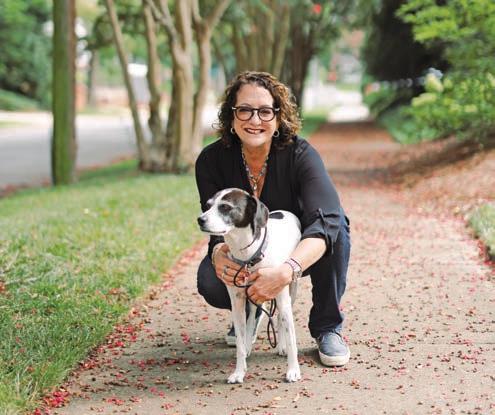





"A spirited forum of Gate City food, drink, history, art, events, rumors and eccentrics worthy of our famous namesake"
I thought I knew what chow chow was, a traditional Southern relish that my daddy put on pinto beans and my mother whipped up using up the tail end of the garden — cabbage, onions, green tomatoes and peppers, accented with mustard seeds. When I run out of the version I make myself, similar to Mama’s, I buy what I consider a really decent alternative, Mrs. Campbell’s Chow Chow, made mostly from cabbage, red bell peppers and onions, and produced by Winston-Salem's Golding Farms. (Tony Golding got started in 1972, making and distributing Mr. and Mrs. John Campbell's homemade version.)
Then I started poking around. Southern? Hardly. Food historian John Mariani informed me that the name of chow chow may come from Mandarin Chinese "cha" and originated in America in 1785, when Chinese laborers working on railroads in the West introduced it, amped up with ginger and orange peel. North Carolina-born "Southern Fork" blogger Stephanie Burt muses that the French Acadians from Canada might have brought chow chow to the United States, since their word for cabbage was “chau." But her personal theory is that "the Carolina version I know originated with the Pennsylvania German and
Dutch settlers, who traveled the wagon road to the South bringing their love of relishes and mustard with them."
My Pennsylvania Dutch mother might have consulted her Mennonite Community Cookbook, but she sure didn't put any lima beans, green beans or cucumbers in hers. She used the version, as I do, from the Rockingham County Home Demonstration Cookbook, featuring, like Mrs. Campbell's, cabbage, onions and peppers, but also green tomatoes. Head north and chow chow gets even greener, made predominantly with green tomatoes, especially in Nova Scotia and New Brunswick.

If you want to make some from the remnants of your garden veggies, type into Google what you have too much of and you'll find oodles of recipes.
But what really grabbed my attention was what some people do with it. Sure, I heap it on hamburgers, hot dogs and collard greens. And it’s the secret ingredient in my devilishly delicious deviled eggs. But, really, fish cakes and mashed potatoes? Heaped on biscuits and gravy or on corn bread? Don’t even mention ice cream — unless it's chocolate. — David Claude Bailey

You know the house that the kids clamor to every Halloween? It’s the one with the flashing lights, “Monster Mash” blaring and a fire pit out front surrounded by witches and werewolves sipping their brews. Green with envy? Don’t be — we’ve got tips to make your front door the top stop on the block.
Don’t dole out off-brand candy imposters. No one wants your Crisp-Cat, Wacky Taffy or Chuckles bar. Even toddlers know they’re a cheap imitation of the real thing and taste like chocolate-covered disappointment.
The biggest fright of the night? Nothing screams “I’m a dentist” like handing out toothbrushes at the door. If you’re going to do it, at least toss in some sugar-free candy, too. Plus, from a business standpoint, more cavities means more income.
Ambience? More like zombie-ence. Think eerie mood music, orange and purple lights and — the icing on the individually packaged Tastykake, which also makes a great treat — a frightful ’fit for yourself. And we all know nothing is scarier than a homemade Halloween costume.

Captured on the heels of the Great Depression, these two goblins are prepared for the coldest of winters and the largest of pumpkin pies. Better stock up on the whipped cream!
While one red balloon floating up from a drain says “Stephen Kinglevel creepy,” soon, several red balloons in front of an art studio will scream creativity. Since 1996, ArtStock Studio Tour has offered art collectors and lovers the opportunity to tour several local studios — marked by red balloon bouquets — where they can peruse and perhaps purchase a piece for their own homes. This year, ArtStock is stretching that canvas all the way into High Point. Witness here the work of Greensboro resident and mixed-media artist Linda Spitsen, who is participating for her third year. For the first time, she plans to open the doors to her in-home studio. Spitsen says she traces her creativity all the way back to kindergarten. “For forever, people have always received a handmade card from me for their birthdays,” she says. But that creativity was reignited on a larger scale in 2016 when she retired from a longtime career as vice president of HR at a tech company. Now, Spitsen has collectors all over the globe — “in all the continents but Antartica,” she quips. Her brush, she finds, generally yields works that are floral or earthy in nature, as seen here in Thursday’s Child, a bold acrylic on gallery-wrapped canvas. Asked who, exactly, Thursday’s Child is, Spitsen simply says, “I was born on a Thursday.” As was her husband, Stu Nichols, she notes. The painting, as it turns out, was completed on the eve of her birthday earlier this year. Just follow the red ArtStock balloons to see Spitsen’s work as well as that of 30+ local artists, Oct. 2–5. Info: artstocktour.com

Poplar Hall, a Neoclassical Revival home in Irving Park, now features what may be the first tree that’s been remodeled of its kind — notable in a neighborhood where grand old mansions routinely receive every imaginable home improvement.
You read that correctly. If tree superlatives were handed out, this tree would win “Most Improved,” hands down!
The much-loved oak stands on the lawn of the historic 1914 family home of politician and lawyer Aubrey Brooks. Poplar Hall was among the first houses built in Irving Park. In recent years, arborists and experts could be seen administering TLC to a particular tree, across from the entrance to the Greensboro Country Club.
Why care so for this tree? It had star power, an earthly wonder to all who passed by.
The same feature that made the tree charmingly irresistible, sparking the imagination, also indicated its vulnerability. Its heartwood having died, its center was enchantingly hollowed out so much so, a child could disappear into its interior.

Generations of fans have visited the tree, standing conveniently by a public sidewalk. Passersby, runners, walkers and parents with strollers have invariably slowed for a better look. Like the Angel Oak in Charleston, South Carolina, it had quietly become a natural attraction, one the children in my family always requested to visit.
Years ago, a fire was set inside the hollow. Though it bore the signs on the charred interior, the tree seemed to defy death.
But, despite the care of intergenerational owners who gave it their best efforts, the tree steadily declined.
Advancing decay and time further ravaged the tree. And who could even guess its age? Oaks often live hundreds of years, according to treehuggers.com.
The ailing oak recently underwent a series of incredible trans-













from 12 to 4
formations. First, a breathtaking amputation. The dying top was lopped off, leaving it truncated and sad-looking. Fans and neighbors worried. What next?
The dead tree trunk — the main attraction — remained with at least 20 feet of the once magnificent oak. The natural “doorway” was saved, its ancient portal still open.
Since then, a cedar shake roof was constructed, reinforcing the tree’s appeal and storybook charm. More embellishments followed: gingerbread trim and two charming windows. Delighted children dubbed it the “Keebler Elf tree” after the well-known cookie commercials, where elves whip up Fudge Stripes in such a tree.
As a final, playful touch, garden gnomes — perhaps Keebler kin — appeared inside the hollow, establishing residency, proving the remodel was a habitable success.
It was a remarkable save for a tree with legions of fans.
But not everyone unreservedly loves the elf tree at Poplar Hall. Occasionally, the darkness of the walk-in tree spooks little ones, fearful of encountering unseen guests.
When my niece, Bailey Sparks, visited the tree, we urged her to step inside for the full experience. Just as she entered the shadowy hollow, she screamed out in pain and fright. A bee had stung her.
Later, she shakily recorded the event on a blackboard in my home, which bears chalk-scrawled messages from visiting children. “I will never forget this day! The first day I got a bee sting! July 15, 2007,” she wrote. The child had no more to say on the subject, wishing to never return.
But the majority of those paying homage to the tree get a pleasurable shot of dopamine rather than bee venom. Most of us are tree lovers, like generations of the Brooks family seem to be.
According to historic records, the name itself is proof. Poplar Hall is the namesake “of a stately tulip poplar” that stood on the front lawn of the property more than a century ago. — Cynthia Adams




Terms and Conditions: $300 off any order of $1198 or more,$200 off any order of $998-$1198 or $100 off any order of $698-$998, on any complete custom closet, garage,or home office unit. Not valid with any other offer. Freeinstallation with any complete unit order of $600 or more. With incoming order, at time of purchase only. For a limited time SPECIAL FINANCING for 18 months *with approved credit* Expires in 90 days. Offer not valid in all regions.





(September 23-October 22)
True luxury comes in many forms: Egyptian cotton, Belgian linen, Mongolian cashmere and Ahimsa silk. But have you ever felt the plushness of making a decision sans agony, anxiety spirals or paralysis? The ethereal lightness of refusing to overthink? When Venus enters your sign on Oct. 13, be open to receiving a new kind of abundance — that of an unshakeable inner peace. Everyone wins, and you’ll get to dodge the rabbit hole.
Scorpio (October 23 – November 21)
Stop settling for crumbs.
Sagittarius (November 22 – December 21)
Just unsubscribe already.
Capricorn (December 22 – January 19)
Cozy up with the chaos, baby.
Aquarius (January 20 – February 18)
Hint: Add cardamom.
Pisces (February 19 – March 20)
The truth is always a mercy.
Aries (March 21 – April 19)
Mind your tongue.
Taurus (April 20 – May 20)
Address the energy leak.
Gemini (May 21 – June 20)
Resist the urge to ghost.
Cancer (June 21 – July 22)
It’s time to update your software.
Leo (July 23 – August 22)
Listen for the crows.
Virgo (August 23 – September 22)
Embrace your feral nature. OH
Zora Stellanova has been divining with tea leaves since Game of Thrones’ Starbucks cup mishap of 2019. While she’s not exactly a medium, she’s far from average. She lives in the N.C. foothills with her Sphynx cat, Lyla.












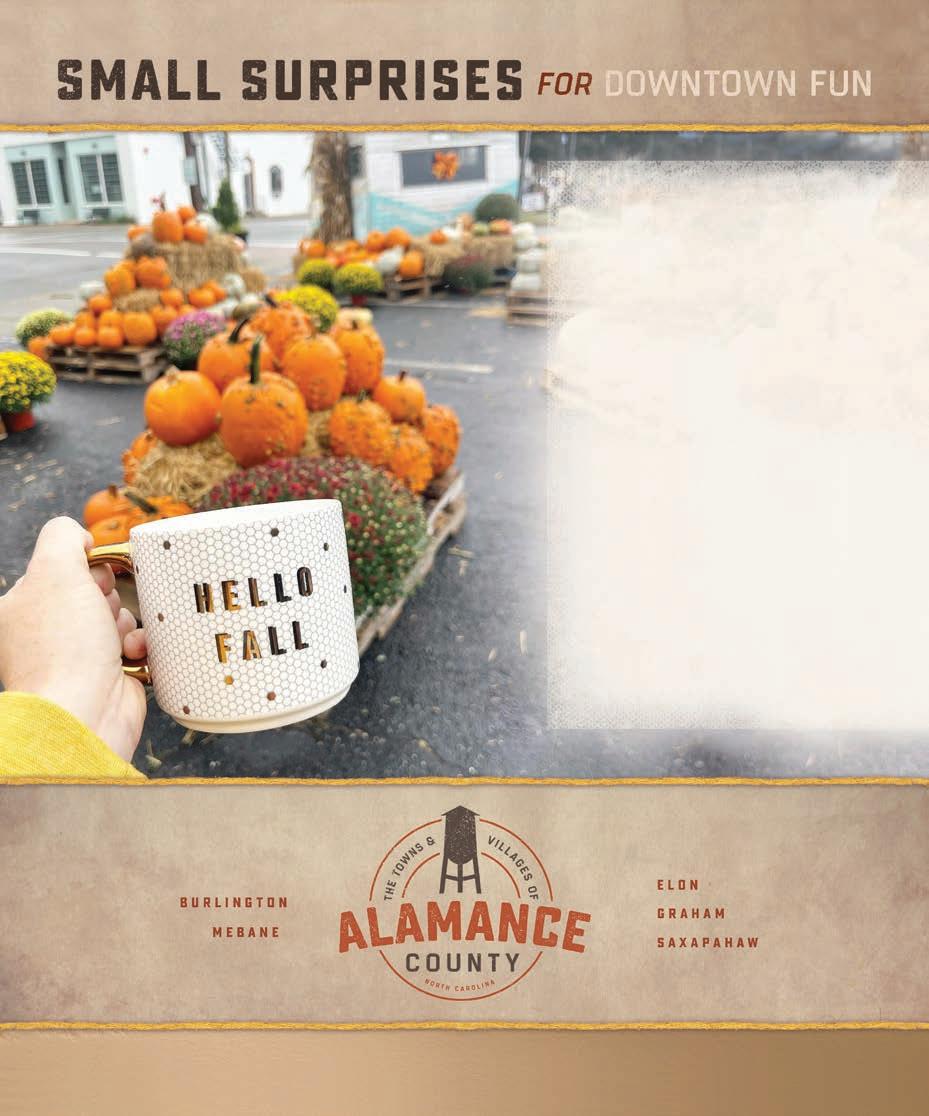
Curious on what you may find in our downtowns? Experience the vibrant charm of fall by strolling our downtowns and experience our small-town charm. Discover local shops, quaint bookstores, clothing boutiques and galleries featuring artisan crafts.
Mark your calendars!
Autumn Fest – October 4th
Hook & Line: Thompson Music & Arts Heritage Festival – Oct. 10th & 11th
OBSN Pow Wow – Oct. 11th & 12th
You’ll find small surprises lead to big memories in Alamance County.
by m aria Johnson
Istoop in the dew and get to work, left hand sorting, plucking and tossing the intruders from our vegetable garden.
Don’t ask me why someone who strongly favors her right hand for all other pursuits always weeds with her left hand.
All I know is, my south paw is more sensitive to plants. It’s the hand that caresses leaves and blossoms. It’s also the hand that gauges, with a slight tug, if I can uproot a weed with one yank or if I need to wrap the stalk around my fingers for more leverage.
Is my left hand the gateway to my loosey-goosey right brain, cross-wired hemispheres being what they are? Is that why I enjoy weeding so much? Because it connects me to another brain space?
For my mom, that activity was ironing, the rote chore that allowed her to enter the zen zone, a place where her hands did necessary work while her mind moseyed.
I did not inherit her need to press fabric from rumpled foothills into starched flatlands.
But I do respect, and have my own version of, making things visibly better and finding oneself by getting lost in the mundane.

When I need to get grounded, and think fresh thoughts, you’ll find me literally down in the weeds.
There’s always a bumper crop around our raised beds where, in summer, we intentionally grow tomatoes, peppers, basil, oregano, green beans, eggplant, parsley and leeks.
Unintentionally, we provide a nursery for crabgrass, mock strawberry, knotweed, wild violets and clover.
I cringe as I type “wild violets and clover.” How could I discard them? They sound so Simon & Garfunkel.
Then I remind myself of the truest definition of a weed: Something that grows where and when you don’t want it.
I’ll see you in the cover-crop days of winter, clover. For now, you’re out of here. You, too, tiny pines and oaks and maples. Go make a grove elsewhere.
Here, I tell myself, in order to bring order, and to practice the “culture” in agriculture, I must be a ruthless editor.
And that, of course, is the moment I see an odd interloper. It peeks, broad-leafed and hearty, from a clump of daylilies in the flower border around the garden.
Squash? Is that you?
We tried growing yellow squash in one of the raised beds a

few summers ago. Soon enough, the squash bugs moved in and we, being averse to pesticides and herbicides, let them sap the sunshine from our stir-fried dreams.
Is this a descendant of those ill-fated plants, or a bird-borne volunteer that found a fertile niche in the shelter of the lilies?
I study the outlier, consider yanking it from its safe harbor, and decide to let it be.
Why? Curiosity maybe. What will you become, oh bold and fuzzy one?
A few days pass. The volunteer grows quickly. Already it has bounded over a patch of struggling dianthus and jumped the low barrier that keeps Bermuda grass out of the garden.
Once again, I come close to pulling it out of the ground, but the truth is, I like a vine with chutzpah.
I hold off.
A week later, the vine has advanced a couple of feet on the diagonal. Its goal: to cut the corner of the garden to the sunniest spot in the yard.
In 2020, when we built the raised beds as a COVID project, both to occupy our stay-at-home time and to feed ourselves should broken supply chains threaten our arugula consumption, we did a sun study.
We took pictures of our yard at various times of day, from the same vantage point, and compared the pictures to see which area stayed sunniest the longest.
We built the beds as close as possible to that spot, avoiding a grassy drainage path that, during thunderstorms, concentrates rain water into an overland river.
But this headstrong vine does not care about drainage; it is racing toward maximum sunlight, as if it has a copy of our sun study.
“Follow me,” the volunteer seems to be saying, “I shall lead you to brighter days.”
Baloop. Over the other corner of the Bermuda grass barrier. Baloop. Over a clump of phlox in the border, into the open yard, We let it go. Jeff even mows around it.


I am reminded of children. They might not take the path you thought they would, but, when they are full of vigor and confidence, there is indescribable pleasure in standing back and letting them become whatever they will be.
This is why I garden: for lessons and metaphors writ small, in the dirt.
Overnight, it seems, the vine marches on, popping open more green umbrellas, large five-lobed leaves, as solar energy collectors.
It’s now 15 feet away from its starting point. I joke, with uneasy ha-has, about how it’s coming for the house.
I part the hairy leaves and look for evidence of squash. I see lots of bright yellow blossoms, some with bulbous bases, and lots of woody curlycues.
I cave to artificial intelligence, take a few pics with my phone, and ask Google to identify the plant.
My hopes for yellow squash are squashed. But my hopes for jack-o’-lanterns are lit.
This is field pumpkin.
We leave for a week’s vacation, informing our house sitter that, yes, we know about the runaway vine and, we think it’s harmless, but, you know, call 911 if you hear a window slide open in the middle of the night.
We return to a new development. The vine has decided to


divide and conquer. One branch has made a U-turn and is charging for the garden gate.
The other fork is running up the grassy swale.
Both offshoots lead the way with closed, green blossoms that sprout tendrils like catfish whiskers.
We are in the homestretch of summer, the giant leaves are showing their age. They are mottled with mildew. Bugs have chewed some of their edges into brown lace. The main trunk of the vine, woody and pale, has been bored in places. Many of the blossoms, including the ones pregnant with fruit bulbs, have been snipped clean off, probably by the family of rabbits that live under the knockout roses and drive our hound nuts.
She has caught at least four bunnies this summer, and we have scolded her each time. Now, we look the other way.
Ruthless editing.
One tiny, round green fruit survives at this writing.
We make it a straw bed and surround the vine with plastic rabbit fence.
We are won over by the vine’s will to survive, its ruthless pursuit of light and life. OH
Maria Johnson is a contributing editor of O.Henry magazine. Email her at ohenrymaria@gmail.com.




We’ve made our home here, let’s do the same for you.

By A nne Blythe
Jason
Mott gets one thing out of the way right off the bat in People Like Us — his latest novel is semi-fictional. Or at least that’s what the National Book Award-winning author of Hell of a Book wants you to believe.

“Whole fistfuls of this actually happened, sister!” he tells us in the forward. “So, to keep the lawyers cooling their heels instead of kicking down the front door with those high-priced Italian loafers of theirs, some names and places have been given the three-card monte treatment and this whole damned thing has been fitted with a fictional overcoat.”
People Like Us is the story of two Black authors — one on tour in the wintry climes of Minnesota after a school shooting, and the other being chauffeured around Europe, or “Euroland,” as he calls it, as the guest of a super-wealthy benefactor we know only as “Frenchie.”
They’re both exploring the idea of the American dream and whether such a notion is truly attainable within the confines of their lives. One is pondering that question from inside U.S. borders, the other from the outside.
Readers likely will notice many parallels between the real life of the acclaimed Columbus County resident and UNC Wilmington professor who’s a five-time author now. Mott started writing People Like Us as a memoir that delved into his relationship with America.
But along the way a couple of his Hell of a Book characters — Soot and The Kid — kept dropping into his story. So it evolved into this description-defying, pseudo-memoir/novel that will make you laugh out loud at its devilishly delicious humor, then sink into the grave realization that Mott is deftly addressing some serious social commentary.
Because both protagonists feel compelled to travel with concealed weapons, the gun culture in America and abroad is one such theme. So is the precarious state of the nation.
Mott is not preachy about these topics. He is subtle and inviting as he gets readers to think about American identity, and the complexities that Black Americans confront in a land where racial “othering” still exists.
One of the beauties of his writing is he can turn a phrase that will stop you dead in your tracks and force you to linger for a minute or two to admire his imagination, wit and way with words. Mott describes a scene about a seismic shift on a par with the protests that followed the murder of George Floyd this way: “It was like watching Sisyphus — a man who never skips leg day — finally get that super-size rock of his farther up the hill than he ever did before. And, just for a second, you can believe that, hell, maybe he’ll finally get it over the top.”
Mott’s prose will take you on a madcap adventure or somber journey with a cast of intriguing characters. We reconnect with Soot, the character in Hell of a Book who becomes invisible or one of “The Unseen” after witnessing his father shot by police while out on a jog. He’s an author now, in Minnesota, reckoning with the suicide death of his daughter, Mia, amid the aftermath of a school shooting.
Then there’s The Kid, who is older than he was in Hell of a


« October 23, 6:00 pm: Haunted Vintage Game Night « October 26, 2:00 pm: Come Sunday Jazz: Brandon Mitchell
Also this month at Weymouth Center:
Oct. 2 - Nov. 1:
October 2:
October 3:
October 9:
October 18:
October 21:
October 28:
November 1:
Spirited Stories:
Tales from the Writers Self Guided Tour
A Novel Approach to History; Unveiling the Unseen
Meet the Author: Rylee Hayes
Meet the Author: Ed Southern
One Wonderful Night
James Boyd Book Club: The Returned by Jason Mott
Song Circle Jam Session
Open House and Self Guided Tour


omnivorous reader
Book, mysteriously seizure-prone now, living in France and going by the name Dylan — or at least the author living it up bourgeois-style in Europe believes the two are one and the same despite being told otherwise.
We get to know The Goon, the giant Black Scottish bodyguard and driver employed by the eccentric Frenchie to squire around the nameless author in a Citroën so decrepit and aged it seems like it’s “about to pull a hamstring.”
Dylan is with them as they go from book event to book event in Italy and France. Along the way, the author, who sometimes pretends to be the betterknown Colson Whitehead or Ta-Nehisi Coates, runs into Kelly, a funeral director and former girlfriend from the States. She hops in with the trio as the four of them seek a “Brown Man’s Paradise.”
Just as the gun used in an accidental shooting toward the end of the book hangs suspended in air “like a steel question mark,” so too does the notion of whether leaving America, as Mott poses, “just might be the new American dream.”
Dylan, who fled to “Euroland,” sheds light on that idea in deep conversation with the author, who is debating himself whether a comfortable home can really be had outside the homeland for people like him.
“There’s a hierarchy here, just like everywhere,” Dylan told him. “You’re either French-born White or Italian-born White or English-born White or Whatever-born Whatever . . . or you’re an Other. Well, where do the Others go? What do you do when your home doesn’t love you and all the other homes you tried to make a life in don’t love you either?”
That question lingers as Mott wraps People Like Us, fodder for one more semifictional book. OH
Scan the QR code for tickets and additional information!
555 East Connecticut Avenue, Southern Pines, NC
Anne Blythe has been a reporter in North Carolina for more than three decades covering city halls, higher education, the courts, crime, hurricanes, ice storms, droughts, floods, college sports, health care and many wonderful characters who make this state such an interesting place.

By SAr Ah roSS thompSon


It’s May 2002, and I make my way up the stairs of Winston Hall at Wake Forest University to meet up with Nick, the graduate student in charge of the bat lab — or The Batman, as I come to call him. He uses his key card, leading me through a labyrinth of locked doors and staircases that end in a dark basement room — a bat cave, if you will. You see, I’ve taken a summer position as an undergraduate research assistant studying bat echolocation. As an eager biology major, I’m ready to get started on this dream job, rabies vaccinations and all. In my first week, we insulate the cave with foam pads to make it fully soundproof for recording bat calls. Nick and I work side-byside for several days, listening to The Best of Sade CD on repeat while he tells me about his home country, Bulgaria, and his dog, Max. By week’s end we finish the room, and I’m gifted a container of fresh feta cheese, a surprising but welcome gesture. The Batman continues to pay me in feta all summer as I hurry along by his side, carrying stacks of notebooks and tools. Just call me Robin.
Our next mission involves collecting bats from the field. And by “field,” I mean anywhere a colony of bats may be living. During the first expedition, I find myself stabilizing a ladder in the dark while The Batman climbs underneath bleachers at a
bring them down one-by-one to a carrying case. The next week, an exterminator tips us off that a woman wants bats removed from her attic. We speed over in our bat mobile (an ’80s hatchback), crawl into the hot, clammy attic space, and secure the bats.
Once the great migration of bats to the bat cave is complete, I’m tasked with cleaning their cages and providing them with daily food and water. Simple enough, except that, believe it or not, I don’t particularly like bats. In fact, years of media villainization have left me terrified of them — especially that they’ll somehow get caught in my hair. As I peek inside a cage, psyching myself up to clean, I see a cauldron of bats hanging upside down, their beady eyes glistening in the red light of my headlamp, and I draw back with a gasp. In another cage, a bat is gripping the wire door, so when I open it, he swings open to greet me. The stuff of nightmares. Only after some serious self-negotiation am I able to squeeze my hand through the smallest crack in each door. Mission accomplished.
Finally, what we’ve been waiting for — we begin our experiments with bats and moths in the lab. It turns out that moths can emit a buzzing sound to “jam” a bat signal and avoid being eaten. We want to capture the sound waves of that particular moment of survival. Nick turns on the sound recording device, we turn off our headlamps and crouch down, waiting in the darkness, as Hercules (our favorite bat – yes, we name them all) starts to circle the cave. In his quest for food he repeatedly flies within inches of my face, close enough to feel the wind from his wings tickle my skin. Each time he swoops by he slows just enough to get a look at me, and I at him. I surprise myself by not being afraid, but instead feel a tingle of exhilaration each time he passes.
Mere weeks later, I’m now feeding the bats by hand (Holy Toledo, Batman!) and spending hours alone in the bat cave running experiments. There’s a tranquility found in that room, the bats whirring around me again and again, and I grow to enjoy the dark. “I am darkness, I am the night.”
We also raise baby bats in the lab, and I find I am falling all over myself to help. Wrapped up in tiny bundles, the babies greedily accept formula we feed them through droppers. Just like with human babies, we wake to feed them in the middle of the night. I leave a summer party at 2 a.m., announcing that I must go feed baby bats (surprisingly, no one questions this). In the stillness of the lab, my ears still ringing from the blaring music of the party, I drop milk into their little mouths.
When the babies are older, I take them out one-by-one and walk around the bat cave while each bat hangs upside down from my finger. As they feel the air under their wings, they begin to open them, eventually extending them fully to push off and take their first flight. I sit in awe. I’ve just taught baby bats to fly.
Throughout my summer in the bat cave, I meet other bat lovers. Led by The Batman, we’re a motley crew — all of us used to spending hours alone in darkn ess. One has a bat tattoo, another a bat navel ring. We have cookouts and gatherings. We give each other bat-themed gifts (the children’s book, Stellaluna, being one). As the summer ends, I sign up to work in the bat lab during the next academic year and again the following summer, having found my place in Gotham City.
These days, I no longer study bats, but I sometimes wish I did. In those quiet moments in the lab, I experienced a peace that I’ve never quite been able to replicate. One that comes from watching, from listening and from being still in the dark. A few years ago, I met up with The Batman, who now is an internationally recognized professor. We enjoyed a glass of wine and discussed the research that we each do. As a lifelong Robin, I’m hopeful that we can work together again one day. I’ll await the bat signal.
Sarah Ross Thompson lives in Greensboro with her husband, John, and her children, Owen and Ellie. A psychologist by training, she finds getting lost in the woods and writing little stories to be two of life’s greatest therapies.
Established as a family-owned and -operated home care agency, our mission is to enable individuals to remain in the comfort of their own homes. In 2010, Lisa Clapp Hmiel made the difficult decision to leave her family’s nursing home following a devastating race car accident that paralyzed her son. This pivotal moment inspired Lisa and her youngest son, Tyler, to open Home Helpers of Jamestown in 2013. Our goal is to offer everyone the same compassionate and loving care provided to her son, Shane.









Daniel Johnston’s art and life find new meaning
By liz A roBertS
Celebrated Seagrove ceramic artist Daniel Johnston has always asked his work to carry a lot of weight. The clay vessels and pillars and bricks he forms and fires in Randolph County are beautiful; they’re also packed with a powerful purpose that has fueled his ambition for years. His works carry complicated stories about land, especially the place where he makes them and his life there. They’re dense with technical prowess, the multicultural lineage of that learning, and the demonstration of those skills. And they’re conceptual, freighted with ideas, wise to the history of art and its evolutions.
But lately, Johnston has begun making art differently. He’s thinking about it differently. The catalyst has been his marriage to artist Kelsey Wiskirchen and the February birth of their first child, Joseph Elliott Johnston.
“There’s the feeling that I have a greater purpose in life as a father,” he says. “The work, I can see, has had a bit of a breath. In a way, if it had a life of its own, it would thank me for taking the pressure off of it a bit.” If his art no longer needs to prove his human worth, Johnston muses, perhaps it can begin to speak for itself: “It frees my work up to be more mature.”
At the moment, that new work is destined for a substantial fall installation at the Gerald Peters Gallery in Santa Fe, New Mexico. He plans to install his pieces there — as many as 50 large pots and several of the wall-hung clay brick assemblages he calls “block paintings” — in a series of rooms he’ll create out of 80-odd discarded wooden walls he salvaged from the High Point Furniture Market.
Building environments for his work is not new for Johnston. “So much work that is impactful and changes people’s lives, it’s all content in context. The architecture of the room, it gives it context, and, in a way, it removes the pressure from that object. [The installation is] a bit of a Trojan horse, so that the viewer can softly let [the object] in,” he says. “If I can start controlling how you feel, then I’m able to allow you to see my work in the way I want to communicate it.”
Also on display within this context, possibly: previously unseen paintings made not of clay, but of paint on canvas or board. “This would be the first time I’ve ever exhibited paintings that weren’t three dimensional,” he says. His constructed wood-walled installation would be a good place to show them, he says, because they’d become part of a larger artistic immersion. “If you go into an installation, you are walking into an installation, you’re not walking into an exhibition of paintings.” Still, he’s not yet ready to commit. “Maybe I won’t exhibit them if I don’t feel they’re strong enough.”
Taking his time is part of his practice. Abstracted, sketch-like paintings of vessel-


shaped forms have shown up on his studio walls in recent years, but the paintings he may include in the Santa Fe installation are likely to be inspired by the landscape of New Mexico and the tobacco barns of North Carolina. Some will be painted on land he owns next to Carson National Forest in New Mexico, and some will be painted at home in Seagrove. “I’m absolutely in love, architecturally, with the tobacco barn,” he says. “It’s just such a brilliant piece of architecture.”
Johnston lives and works in a house and studio he built with his own hands. It reflects his long-held appreciation of the tall, timbered barns traditionally used to cure tobacco. It’s a log cabin the size of two barns put together, with big pots all around it, some sunken in the grass and some on pedestals.


“ Thank you Greensboro for 40 amazing years!”
It sits on 10 acres of land he bought at age 16 with money he’d originally saved for a Ford Mustang — land where, at that young age, he built himself a shack to live in, alone, after he dropped out of school. Years later he felled the trees to build this house and studio.
When I first met Johnston there seven years ago, he was humble as he told his story and surveyed his place. Growing up not far from there in extreme poverty as the child of tenant farmers, “in my mind,” he says, “land was power.” He told himself early on he would make for himself a different kind of fate.
The same could be said of his art.
About 15 years ago, after lengthy apprenticeships with potters in Thailand and England and with Seagrove’s internationally revered Mark Hewitt, Johnston became a leading American maker of big pots. He perfected a


technique to turn 100-pound lumps of clay into giant vessels that could hold 40 gallons apiece and made them in huge numbers, a series of 100 pots one time, 50 pots another. The acclaim was exciting, but then became disillusioning. It broke his heart to see them carted away, one by one. It was the groupings, he realized, that held the meaning: “People had to have a piece of it. As soon as they had that jar, it had no context.”
Johnston eschews that kind of work today. Now, he’s not concerned with demonstrating his finesse or with making beautiful objects unless they have conceptual meaning. At the North Carolina Museum of Art in 2019, he sunk 183 individual woodfired ceramic pillars in a permanent installation across the gentle hills of the park landscape to evoke an organic border, fence or outcropping. In 2021 at NC State University’s Gregg Museum of Art & Design, he built a massive wire-mesh, house-shaped frame — a temporary building at once empty and full — to hold several giant pots, many irregularly shaped, and some put together like bricks in a foundation. It was a paradox: lonely but inhabited, open but caged, refined but deformed.
“I’ve never thought of myself as a potter, and I don’t really like the title. I want to work with my mind, not my hands,” he says. “Like Duchamp’s Fountain.” He’s referring to a porcelain urinal the French conceptual artist Marcel Duchamp exhibited in 1917,
considered a seminal moment in 20th-century art. Duchamp rejected what he called “retinal” art, or art designed to please the eye, and wanted his art to provoke the mind instead. “I think about that a lot,” Johnston says.
Recently, caring for his newborn son and also for his aging father, who suffers from dementia, has allowed Johnston to spend more time in thought than his typical schedule of constant studio work allows.
“I’ve been working my mind, which is really probably the place that I spent the least time before he was born,” he says. “I can look back now and see that I had filled my time with things that kept me from using that bit of my brain. And so now it’s the opposite of it. I’ve had a huge amount of space to use that part of my brain.” The result, he says, is the kind of artistic evolution that lies beyond the acquisition of skills. “The nice thing is that once you have the security of your skills and your abilities under your belt, there’s always a huge amount of room to improve. But so much of the work is mental and thought at that point. And so I have been working that way.” OH
This is an excerpt from Art of the State: Celebrating the Art of North Carolina, published by UNC Press.







By Cynthi A A dA


to go shopping, especially for groceries. What he didn’t like was being hurried. Choosing the best rib eye might require a solid 10 minutes.
“Marbling,” he’d murmur, scrutinizing the fat flecks of a steak with surgical interest as the butcher waited.
Clothes shopping was no different. He often joined my mother, egging her on to try dress after dress, evaluating each frock. Was it too short? Too frumpy? Did it overpower her small frame? Mama, an impulsive shopper, had little patience for long deliberations.
She liked flash and bling as much as Dad liked fat-streaked T-bones. Whether a pork chop or a pant suit, he analyzed purchases with a strange dedication.
Dad earnestly believed he could save Mama from fashion crimes. He steered her towards classics, well-tailored and simple, long before the quiet luxury trend. But Mama leaned into flamboyant femininity — heels, furs and cocktail wear in the daytime. Liz Taylor and Joan Collins were lifestyle icons.
Mama wore a cocktail ring and negligee while rolling out biscuit dough at breakfast. Come evening, she never missed a Dallas or Dynasty episode. Afterward, she took long baths, emerging dewy-skinned in something diaphanous, trailing cologne de nuit.
She reminisced about starring in Fairview High School’s play, imagining a career on stage. If not for the traditional life she chose, including five children and an annoyingly opinionated husband, she might have lived the life of Liz.
At the very least, she planned to look the part.
Their shopping forays were certainly like watching Liz and think Warren?” as she pivoted, he would artlessly offer his first reaction: “Shug, that dress is wearing you.”
Mama would purse her lips, burnished red with Revlon’s Cherries in the Snow, and shoot him a withering look.
Nonetheless, Dad wanted his opinions sought when it came to dressing what he considered “his” women. When I needed a prom dress, he volunteered to take me shopping. Inwardly, I dreaded the inevitable critique before we drew up outside the Belk store in Monroe.
He zeroed in on the most chaste dress in the junior department — a ballerina-pink dress prettily embroidered with rosebuds. I emerged from the dressing room looking like a cupcake. This was not what I was aiming for, but he practically cheered with approval.
My father adored a dress that made me look like a Nutcracker extra.
When I tried on a less modest number more like what my friends were wearing, he dropped a truth bomb.
“Honey, you don’t have the bustline to pull that off,” he observed. My face flamed with heat.
This was the kind of feedback Mama loathed.
Dad thrust the rosebud dress into the clerk’s hands, despite my fallen face. Come prom night, the virginal dress paired with my slumped posture read more Patty Duke than the sultry Daisy Duke I’d hoped for.
Cheerleaders and majorettes swanned past me in spaghetti straps and push-up bras as I spent the night loitering by the




punch bowl with a completely tonguetied date. My main activity was ruing my reflection during nervous restroom treks.
Mama would never have worn that dress. She’d have fought him on that. After all, she fought him all the way to divorce court.
Afterwards, she went full-tilt glam without Dad there to inhibit her impulses. Mama’s hairdo grew so high no one but her hairdresser could say where her scalp ended and hair began. She wore the highest heels even when her bunions screamed.
On a trip to Florida, she bought a door-knocker of a cocktail ring with a purported connection to the Super Bowl. The governor was off the accelerator and Mama swiftly blew through her divorce settlement.
Nearly broke, she took a job at a new consignment shop.
Wealthy women with nearby lake homes consigned their finery there and Mama got first dibs. While she had seldom dressed better, she loathed wearing “second-hand” fashion, even while enjoying more wardrobe changes than Cher.
None of that mattered.
When I praised a chic Chanel dupe she wore to a family dinner, she hissed at me, annoyed, “It isn’t real!”
As soon as she left that job, she resumed her preferred buying habit of new only.
I turned out to be quite the opposite, thrilled whenever I score a good knockoff, vintage find or a designer hand-me-down.
Nonetheless, while Mama may not have inspired thrift, she modeled individuality, conformity be damned.
Recently, a young friend met me for a drink sporting turquoise-colored hair. How could I not comment? I complimented her, privately thinking I have never been so free, nor so brave. She replied, “You can be ruled by all of the things that everyone else wants from you, or you can just have fun with your life.”
And just like that, I imagined Mama, radiating approval. OH













By SuSA n CA mpBell
There! By the edge of the road: It’s a big, dark bird. It looks like it could be a wild turkey. But . . . is it? A closer view reveals a red head and face with a pale hooked bill, but a neck with feathers and a shorter tail. Definitely not the right look for a turkey — but perfect for a turkey vulture. This bird is also referred to as a buzzard or, for short, a “TV.”
Making an identification of these odd-looking individuals is somewhat harder these days since wild turkeys have made a good comeback in the Piedmont of North Carolina. Turkey vultures and turkeys can occasionally be seen sitting near one another in an agricultural field where they may both find food or are taking advantage of the warmth of the dark ground on a cool morning.
Turkey vultures, however, are far more likely to be seen soaring overhead or perhaps perched high in a dead tree or cell tower. They have a very large wingspan with apparent fingers, created by the feathers at the end of the wing. The tail serves as a rudder, allowing the bird to navigate effortlessly as it’s lifted and transported by thermals and currents high above the ground. These birds have an unmistakable appearance in the air, forming a deep V-shape as they circle, sometimes for hours on end.
It’s from this lofty vantage that turkey vultures travel in search of their next meal. Although their vision is poor, their sense of smell is keen. They can detect the aroma of a dead animal a mile
or more away. They soar in circles, moving across the landscape with wings outstretched, sniffing all the while until a familiar odor catches their attention.
Turkey vultures are most likely to feed on dead mammals, but they will not hesitate to eat the remains of a variety of foods, including other birds, reptiles and fish. They prefer freshly dead foods but may have to wait to get through the thick hide of larger animals if there is no wound or soft tissue allowing access. Toothed scavengers such as coyotes may actually provide that opportunity. Once vultures can get to flesh, they are quick to devour their food. With no feathers on their head, there are none to become soiled as they reach into larger carcasses for the morsels deep inside.
Vulture populations are increasing across North Carolina — probably due to human activity. Roadways create feeding opportunities year-round. Landfills, believe it or not, also present easy meals. In winter, the northern population is migratory and shifts southward, so we see very large concentrations in the colder months. The large roosting aggregations can be problematic. A hundred or more large birds inhabiting a stand of mature pines or loitering on a water tower does not go unnoticed.
Except for birdwatchers and those who live near a roost site, most people overlook these impressive birds. Often taken for granted, they are unparalleled scavengers, devouring the roadkill our highways inevitably produce. OH
Susan Campbell would love to receive your wildlife sightings and photos. Her email is susan@ncaves.com.










By Billy ingr A m
“There are perhaps
no days of our childhood we lived so fully as those we spent with a favorite book.”
— Marcel Proust

Is there a beloved storybook you fondly recall being read to you as a child? For me, it was Pat the Bunny by Dorothy Kunhardt. Credited with being the very first interactive book, it offered tots a “touch and feel” experience in lieu of a narrative. Bound with white plastic ribbing, each turn of its pages reminded toddlers of everyday experiences, like feeling Daddy’s stubble (a schmear of sandpaper), inhaling the scent of wild flowers, playing peek-a-boo with a patch of cloth and patting an upright, bunny-shaped fluff of faux fur.
For lovers of children’s pictorial storybooks, there’s something really special happening this month. Out of 380 proposals submitted by cities around the nation, Greensboro was one of only five boroughs selected to host the Library of Congress’ National Ambassador for Young People’s Literature, Mac Barnett. The ninth to hold this title, he will be presenting Behold, The Picture Book! Let’s Celebrate Stories We Can Feel, Hear, and See, his tribute to the colorful legacy of children’s literature.
Barnett has authored 62 books for youngsters (he estimates) and has received two Caldecott Honors, three New York Times/ New York Public Library Best Illustrated Awards, three E.B. White Read Aloud Awards — the accolades go on and on. Now in its second season on Apple TV+, he’s the co-creator, with illustrator Jon
Klassen, of Shape Island, an animated series based on their New York Times-bestselling graphic novels for toddlers, The Shapes Trilogy, cloudseeding infantile imaginations while simultaneously encouraging critical-thinking skills. Barnett’s The First Cat in Space series, in collaboration with illustrator Shawn Harris, is rendered in a sparkling, modern style with a subtle hat tip to comic artist Jack Kirby’s square-fingered, forced perspective. “Shawn and I have been friends since we were 6 years old,” the author reveals. “And now Shawn is one of the finest children's illustrators working today. When I was a kid, I loved comic strips like Calvin and Hobbes and Garfield.” Admittedly intimidated by the superhero genre, he says, “Shawn read all that stuff and he would explain to me a run of Spider-Man or what was happening to Superman and I would get it all filtered through him.” No dust on these jackets, infectiously fusing a Calvin-ism whimsy with 1980s Marvel super-heroic showmanship, the resulting outta-sight escapades of this far-out feline are what The New York Times proclaims “hilarious.”
For early readers eager for enigmatic entertainment, Barnett’s Brixton Brothers whodunnits serve as a mod nod to circa 1960s Hardy Boys mysteries. School Library Journal declares Brixton Brothers’ premiere volume, The Case of the Case of Mistaken Identity, "one of the funniest and most promising series openers in years." The author’s attraction to those juvenile novels written long ago is rooted in the macabre. “As a kid, I was terrified of being kidnapped,” he quips, “and the Hardy Boys get kidnapped like three times per book.”













Barnett was especially fascinated by the sleuthing siblings’ escape strategy after being tied up. “They would flex their muscles, the bad guys would leave the room; then, they would relax their muscles and the ropes would just fall to the ground,” he recalls. “And I was like, this is what I am going to do when I get kidnapped.” To test this technique, in second grade he convinced Harris to secure him with a jump rope using knots Harris had learned in the Boy Scouts. “I relaxed and, of course, the ropes just stayed there. And I realized the Hardy Boys worked out a lot harder than I did at age 7.” This eventually formed the genesis for his Brixton Brothers’ exploits “about a kid who tries and fails to be a Hardy Boy.”
There is unambiguous, statistical information that reading to children has a lifelong educational impact. “The picture book is one of the great American art forms,” Barnett insists. “And reading out loud to kids is an intergenerational, artistic experience — an adult and a kid coming together over artwork, experiencing it, having feelings about it, and then, hopefully, talking to each other about whether they like it, what they think it means.”
According to Barnett, the first illustrated storybook for kids was Wanda Gag’s Millions of Cats in 1928. “There were books for children before that, primarily though, they were illustrated nursery rhymes, Bible stories, folk tales.” Gag pioneered the use of text and pictures in tandem to tell a story.
“The first book that I really remember living inside of was In the Night Kitchen.” Barnett discovered the absurdist dreamworld of Maurice Sendak as a youngster in the early 1980s. “It just made perfect sense to me. This is what it's like inside my brain, that recognition of a kindred consciousness. And you read it as an adult and you're like, this is such a wild experimental text.”
If offered the opportunity, I think just about anyone would write a children’s book. What advice can Barnett offer?
“You’ve got to learn how picture books work,” he contends. “This is a way of telling stories in a very specific way. It’s easy












to write a picture book, it’s very difficult to write a great picture book. And the first step is to learn the history of the art form to really understand how stories are told
Here’s an opportunity to do just Behold, The Picture Book! Let’s Celebrate Stories We Can Feel, , will be held at 10 a.m, Saturday, October 25, in N.C. A&T State University’s Harrison Auditorium. While he’s in the ’Boro for two days, Barnett will also host programs at area schools, where every student will receive one of his endlessly engaging picture books donated by Candlewick Press (as will the young ones attending the Harris Auditorium celebration, courtesy of Greensboro Bound).
“Greenboro just had an incredible proposal,” Barnett says about the selection process coordinated between The Library of Congress and Every Child a Reader, a literacy charity. “They were looking for communities with strong libraries and bookstores to make sure that these events were of value to the community. A big part of this is talking to adults about why kids’ books matter, why they are real literature and how to make sure that kids have good books to read.” He believes that, for Greensboro, “it’s just a great opportunity to talk to educators, families and even kids about the value of children's literature in a
Award-winning American (and sometimes) children’s author Emilie Buchwald Gildaen: The Heroic Adventures of a Most ) once observed, “Children are made readers on the laps of their parents.” True, it’s never too soon to fold back colorful covers and expose spongy youngsters to worlds of wonder and limitless curiosity. Or just to pet the fluffy cartoon
For information about the free public event, visit greensborobound.com. Registration is strongly encouraged. OH
For decades, Billy Ingram’s go-to gift for newPat the Bunny, still in print after 85 years and 11 million copies sold.





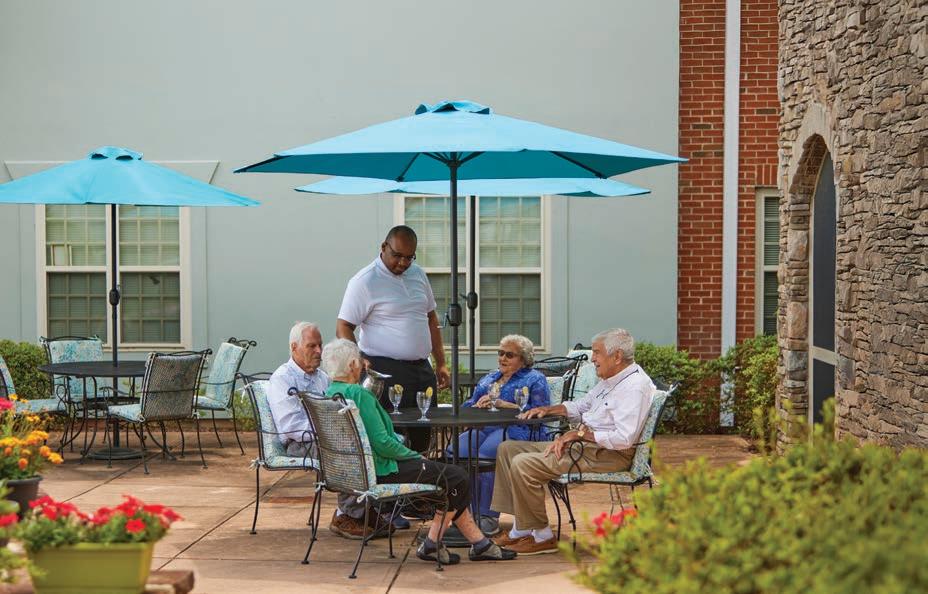


A ghost is no good to a child. Maybe he crooks a finger, as if to beckon the girl to play. Maybe he bounds spritely down corridors, into kitchens. But if she hands him a dolly or ball and he reaches with his spectral hand, he cannot clutch the gift, and if his failed grasp surprises him, if the lack of resistance — for everything real resists the touch — unbalances him, his incorporeal fingers might graze the child’s offering hand. What would you call the gooseflesh raised by the frolicsome dead? There is no joy in it, only a deep well of longing cold, the kind that claws through every crack in the wall.
— Ross White
Ross White is the director of Bull City Press, an independent publisher of poetry, fiction and nonfiction. He is the author of Charm Offensive, winner of the Sexton Prize for Poetry. He teaches creative writing at the University of North Carolina at Chapel Hill and co-hosts The Chapbook, a podcast devoted to tiny, delightful collections. “Little Betsy” is reprinted from The Devil’s Done Come Back (Blair, 2025).

This year’s O.Henry writing contest had a twist. Or was it twisted? We asked you to write your own obituary — because it’s never too late. Until, of course, you are. A team of editors pored (and even argued) over the words of our nearly departed entrants for hours — it was a stiff competition. In the end, several wowed us with the use of humor, quirkiness and literary tools, but there can only be one winner. Between two, it was just about a dead heat, so we also selected a runner up. The rest? Well, they were still cherished by all who read them. And now it’s your turn: Read ’em and weep.
Jane Kester Took the Last Train
With almost no regrets, Jane Kester caught the last train. The one whose daily whistling formed the backdrop of her growingup days in her Guilford County home with the midtown depot. The same one that delivered assurance that life chugs along, mostly at an even pace. She spent most of her life within earshot of the train, each boxcar filled with the cargo of a peak or valley. It seems her time passed by as quickly as the blurred scenery on that moving train; yet the pauses captured in still-shots were the ones that, strung together, formed a panorama of her Earth time.

A series of clips: of a first date in a red-and-white convertible and a lavender dress; of birthing babies and watching them mother their own; of watercolors painted for baby nurseries; of a hand raised at the back of the classroom. There were glimpses of a child saved by a miracle; a daughter’s embrace. Another car held ocean storms and mountain sunsets, Scrabble games and scorched boxer shorts left to dry on a space heater. And there were the snapshots of falling in love for life and falling in love with life. Above the engine’s roar could be heard the laughter, and the music, and the dance. All engineered by the Almighty conductor, keeping it all on track.
The last whistle stop is a fitting landing place.
In a sad testament to squandered opportunity and a truly half-assed effort at life, the family of David Theall announce his passing from this world. Born in the Midwest and raised in the South, David’s childhood was notable only for a complete lack of anything interesting happening at all. Of his three remaining

siblings, only one even remembers his name.
Teen years were marked by a muted rebellious period that his parents failed to notice except when his hair extended beyond his collar. Their belief that a close-cropped haircut would protect you from the evils of becoming a “hippy” was the solid foundation upon which they raised all of their children. (This was particularly difficult for their daughter.) David, an average student who set no academic records, did make it to college, but achieved nothing notable within the hallowed halls. His college roommate remembers him as a quiet type who “may have been a mute.”
After earning a degree in journalism and entering the job market, his colleagues always said, “David has a face for radio and a voice for print, but don’t let him write anything either.” His career spanned several decades of mediocrity, punctuated by a retirement party with only three guests in attendance.
The list of lifetime achievements deserving mention in a forum that charges by the word is, frankly, not worth the extra nickel. Never even close to the brink of greatness, his life will be forgotten by most who knew him and mourned by none.
Mary E. Lewis Took the Trip of a Lifetime
November 8, 1998 – August 29, 2025
We are sad to report that Mary Ellen Lewis is no longer with us. To the surprise of none who knew her, she brained herself tripping over the first flagstone of the path leading to her car, which she walked at least three times daily.

Known as Mellon to her friends (due to an inspired misspelling of her name that happened to resemble the word for “friend” in a fictitious Elvish language), she is survived by her family, two good-as-sisters in other states, and a raunchy Dungeons and Dragons group that still can’t get their initiative order correct.
Her final wishes, verbally conferred, detail that her body is to be thrown into a stratovolcano so that she can finally fulfill her life-long wish of seeing one up close. Barring that, she would like an urn of her ashes to be placed on the doorstep of the local grammar-Nazi, with a hand-written note reading, “your next.”
The measly funds she accrued while living are to go towards buying violins for young students so that they too may know the joys of musicianship (and their parents the bliss of silence following a half-hour of scraping that sounds like a dying feline). Her own violin is to be immolated alongside her.
Any flower arrangements procured for the wake are to be
illicitly-and-hand-picked from the neighbors’ gardens. Libations of green tea are an acceptable substitute.
RIP Mellon
realize how resigned she had become to being a police officer rather than a human being. All three shaped her into an officer, but it took the acceptance of Jesus Christ to make her a better person. The good, the bad and the ugly. 10-42.
“He tried.”



Well . . .
She never imagined she would laugh so much or cry so much doing a job she loved!
Three of many:
A white-headed old man who loved his liquor and had ankyloglossia (tongue-tie). Well, she could hardly contain her laughter in an argument with him. It was a daily occurrence, but she enjoyed it. Later in her career, she saw him one Sunday after a long absence. He was dressed in a three-piece, lime-green suit and sneakers, his white hair washed and combed. He told her he had accepted Jesus and was a new man. He was! Thank you, Jesus!
Second, a shooting incident she was involved in, scared her to her core, but she survived. A drug deal gone bad, vehicle chase and gunfight. He was down, she was still standing! Thank you, Jesus!!
Third, a drowning of a female. A local drunk she thought they had dealt with a million times. It’s raining, with thunder and lightning. Ugh, the Fire Department made it to the call before us, and a fireman is carrying a small child. She cried for hours. Death made her understand just how fragile a life is, made her stop and
True to form, with no planning, even less prep, and, of course, leaving breakfast dishes scattered and one wet load of laundry undried, Sarah Thompson, mother and part-time person, has died. A child of nature and bare feet, she fell victim to the grind in her early years, only to later return to her actual purpose in life, which was walking through creeks, searching for salamanders with her children. A psychologist by training, she became disillusioned with the rigid classifications of her profession and instead believed primarily in compassion, embracing Joseph Heller’s idea that no one should be OK given all of (gestures wildly) “this.” Conversations took surprising turns, as she made a career out of studying suicide, but also once made a fairy mailbox out of a matchbox with her son, each with great passion.
She cried often, rarely passed over a discarded item on the curb, listened to the Indigo Girls’ “Romeo and Juliet” over 10,000 times, gardened without gloves and found peace in painting watercolor fruit on tiny paper. She loved her husband. She cherished her children. Her phone was almost never charged. She found life to be savagely heartbreaking and just as beautiful.
We know that Sarah did not fear death. Instead, she had decided to return in her next life as a bird, just as her grandmothers (cardinal and yellow finch) and her mother (bluebird) had done before. She did not yet know which bird she would be and was looking forward to the surprise.
Born in the Philippines, where babies cry in karaoke pitch and rice is a love language, Lobel “LabelLulubel-Nabel-Hey-You” Lurie entered life already slightly weird and wildly determined.
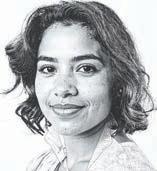
When she left the Philippines, she carried exactly $21 in her pocket, one sturdy suitcase and enough stubbornness to terrify immigration officers. She didn’t just cross oceans — she crossed entire expectations.
Breast cancer survivor. Doctor of Nursing. International speaker. Rockstar nurse. Human spinach detector.
She traveled the world saving lives and occasionally saving people from public humiliation — zipping flies, flicking toilet paper off shoes and praying nobody noticed.
Despite scraping the last bit of toothpaste because small things matter, she consistently carried at least 10 open lip glosses in every purse — proving chaos was part of the brand.
She once gave a major lecture in Spain with a full lettuce leaf stuck in her teeth. Nobody dared interrupt. Probably because she also had the energy of a woman who would fix your life and your fly without blinking.
Her motto:
“Slightly weird but wildly together is the best you can hope for. And if your fly is down, fix it before you embarrass your ancestors.”
Survived by:
•Her daughter, who inherited her spirit.
•Friends and communities now compulsively checking their teeth.
•Half-used toothpaste tubes and a lifetime of fully used dreams.
Long live Lobel Lurie — beautiful, messy, unstoppable.
Mallory Miranda died today, aged 112, just like she always told you all she would, damn it. Don’t bother googling her. A prolific writer, she wrote under pseudonyms so none could pursue her after mistaking her characters as representations of themselves. You will, if googling, find salacious videos made by someone whose stage name was the same as hers. For clarity, her epitaph will read “Mallory Miranda, pseudonyms:” followed by a list of her pseudonyms, concluded “Bite me!”
Mallory was born in California in 1989. She lived comfortably until the 2008 Great Recession. During this period, she learned the traitorous quality of money, then opted to spend her life in willful avoidance of it. She insists this was intentional — not because she spent her entire income on books. Ignore that TBR pile. It’s nothing to do with her lack of fortune. Sir! Madam!
Please, let’s — is that drone delivering more books? Ugh —
As Mallory promised, her COD: None are shocked she finally fell down one too many rabbit holes. Literally. This was not another research deep dive. It was bunnies she refused to exterminate from her yard. Her yard became a sanctuary for critters after neighbors poisoned their yards to the point of no biological return. She always knew moving to North Carolina would kill her, and surely, it was one of these local bunnies’ holes that tripped her. Her calcium-deprived bones couldn’t take it.
Mallory is preceded in death by her husband and survived by her son and library.


As Walt Pilcher, 83, of Colfax was preparing to shuffle off this mortal coil, he looked up “shuffle off this mortal coil” and changed his mind about dying, preferring unlike the tragic Hamlet to invoke his personal 11th Commandment, “Thou Shalt Not Take Thyself Too Seriously,” and dreading the cloyingly glowing and therefore ironically all-the-more funereal sentiments he imagined might make up his obituary, like these: Walt lived life to the fullest and was an inspiration to all. He had a zest for life, chose his own path and died doing what he loved, his way. He loved deeply and laughed often with a heart of gold bigger than the sky, an unbreakable spirit and a smile that lit up the room, a beacon of light in dark times and a guiding light to friends and family. He always had a twinkle in his eye and a story to tell. He was the glue that held us together. Taken too soon, gone from our sight but not from our hearts, Walt never met a stranger and left an indelible mark on everyone who knew him, always putting others first with benevolence and generosity that knew no bounds, touching countless lives with kindness and grace, he was loved by all who crossed his path. His was a life well lived, a legacy of selfless service that endures. Walt will be sorely missed, but Heaven has gained another angel. May his memory be a blessing.
Funeral arrangements are incomplete.
Please visit our website, ohenrymag.com, to read all of the entries we received.

By Cynthia a dams
As Halloween approaches, stories of the paranormal pique our curiosity.
“My Grandfather’s Clock . . . ”
In 1876, British composer Henry Clay Work was inspired to write “My Grandfather’s Clock” by eerie events in a hotel where he stayed, where a tall clock stopped working at the death of one of the brothers who owned it.
The song’s popularity endured. Johnny Cash and Burl Ives recorded the ballad decades later, and countless schoolchildren learned the lyrics.
Yet, Sherri Raeford directly experienced this phenomenon.
“The backstory first,” begins Raeford, a playwright who stages the works of Shakespeare. She appreciates context.
Her mother received a one-of-a-kind Christmas gift 45 years ago from Raeford’s father, Marshall Weavil, who worked for Sovereign Limited, a grandfather clock company in High Point.
“He designed the machines that made the decorative trim, the curlicues on the clock,” Raeford explains.
“He gave my mom a clock — the first ever made by that company.” Inside, it was signed: To Lois with love, Marshall, Dec. 25, 1980.
At his death, his daughter received a grand example representing his life’s work.
“He gave me a bigger, better clock when he passed away,” Raeford says.
Shortly after, Raeford’s mother, suffering dementia, came to live with her. “It was a stressful time.”
Strangely, the clock her father bequeathed her developed a mystifying tendency. “The grandfather clock would stop and go,” Raeford says, seemingly “according to what was happening.”
“The last year of Mom’s life . . . when I would grow impatient with her, the clock would gong at me!” Raeford was incredulous, having never before heard these sounds.
“The last week of Mom’s life, it quit working. I restarted the pendulum, and said, ‘Daddy, she’s not ready.’” Raeford waited.
“The second time it quit, I realized, maybe I’m hanging on to her and she is ready.”
Raeford’s mother died two days later. The gonging stopped forevermore.
“It quit working.”
Raeford inherited her mother’s smaller clock and gave the larger one to a friend.
Aptly, she quotes Hamlet. “There are more things in heaven and Earth, Horatio, than are dreamt of in your philosophy.”
Thomasville’s Finch House is a Renaissance Revival mansion built in 1921 for T. Austin Finch, whose family founded Thomasville Furniture, and his wife, Ernestine Lambeth Finch.
With Thomasville Furniture’s factories shuttered, the mansion fell into decline. In the summer of 2017, Greensboro residents Andrew and Hilary Clement took on its restoration.
Andrew, a contractor, looked beyond the decades of mold and decay. With much of its grandeur intact, he envisioned wedding ceremonies occurring onsite.
The Clements transformed the house into a blushing beauty (Labor of Love: ohenrymag.com/labor-of-love). One too lovely to leave?
“Some of the local police and other residents swear the house is haunted,” Andrew replies.
Ernestine? Out of respect “for the family and their legacy,” Andrew hesitates before admitting to sensing a feminine energy in the primary bedroom and library.
“I have not seen anything, but I feel her presence in both of those spaces, especially at night when the house is empty. One of my construction guys lived upstairs for a period of time and he saw her in old-fashioned clothes several times in that room.”
Later, he sends a detail.

“She’s definitely a benevolent spirit and not scary. One of my girls has smelled her perfume several times in that bedroom.”
On June 26, 1970, Dana Holliday’s father was mortally injured in a tractor accident at age 70.
As his frantic son, Derek Kanoy, tried to resuscitate him, the father calmly reassured him. “He said, ‘Don’t worry about me, I’ll be fine.’”
But he slipped away before paramedics arrived.
“They used to call him Bucky Buddha,” Holliday says. “He was bigger than life.”
Afterward, the brokenhearted family held a reception to honor Bucky Buddha’s amazing vitality. “It was unbelievable, says Holliday. “Friends lined the road leading to the farm. He didn’t want a funeral. Instead, we danced and told stories.”
The family have since created a compound on the farm and live near one another.
One April day in 2020, Derek and his wife Kim snapped a photo while walking from the barn to their house. In the picture, taken at sunset, a small, glowing orb appears directly over the spot
where the fatal accident occurred, almost 50 years later.
“Kim was stunned,” says Holliday. “She might have been taking a picture of the sunset.” Perhaps the sphere of light had appeared before, but this time it was documented. Holliday says the extraordinary sighting was as if Bucky Buddha was signaling all was, indeed, well. “I think it helped.”
Two years before Bucky’s death, Tomiko Smith, a consulting medium who once worked at the Rhyne Research Center at Duke University, told Holliday that she should be “intentional about the way I spent time with him.” Now, she understands.
After years of admiring it, a 1914 Craftsman in a charming Greensboro neighborhood went up for sale. We spent months repairing plaster, painting and scrubbing, thoroughly excising the smell of cat urine and viscous nicotine residue coating each wall of the Westerwood house before finally spending a night.
After moving in, we were utterly exhausted that first night. Around 1:15 a.m., I was awakened by the unmistakable creaking of the stairs.
Heart hammering, I rose quietly. The stairs were flooded with moonlight by a large window at the top. I crept toward the landing and crouched, watching. The sound of footfalls upon each tread

was distinct — but no one appeared.
I returned to bed when the steps stopped, but sleep eluded me. Had it been a lucid dream?
But the scenario repeated the following night. The disembodied footfalls on the stairs returned, at the same hour.
On the third night, again crouching at the top, I jumped when a hand touched my shoulder. “I hear it, too,” my husband said quietly.
I scoured old deeds and newspapers for clues. What had happened in our new home? Whose spirit mounted the stairs each night?
Nothing gave much insight, apart from the fact that records revealed the house had changed hands often, once resold mere months after being bought.
Was it due to what seemed to be a benign ghost?
During an overnight visit from my young nephew, I caught him racing upstairs, his child legs pumping. I chided him about running in the house. He turned to me, eyes wide. “That man’s watching me!”
He pointed back to the empty stairs. I hurriedly distracted him with a children’s book.
Gradually, we made peace with the restless spirit who walked the stairs. Ironically — a tale for another day — a paranormal experience awaited us in our next home. OH
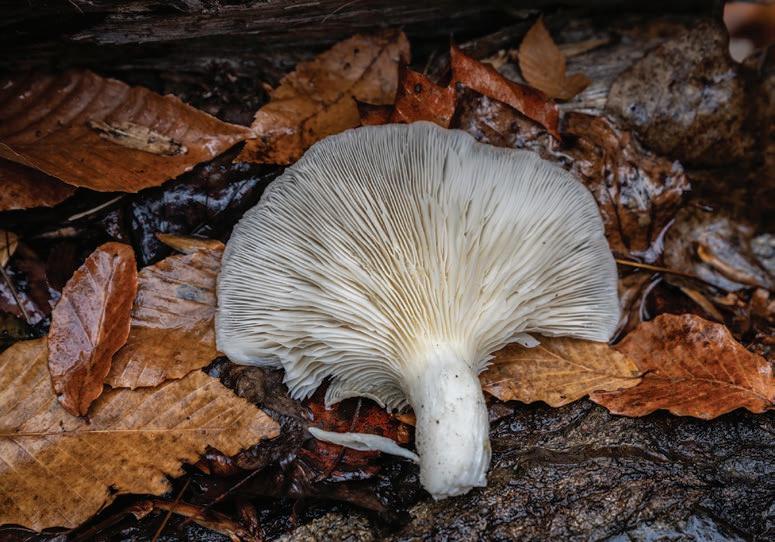

A woodland garden flourishes in an old Winston-Salem neighborhood
By Ross howell JR. • PhotogR aPhs By lynn donovan
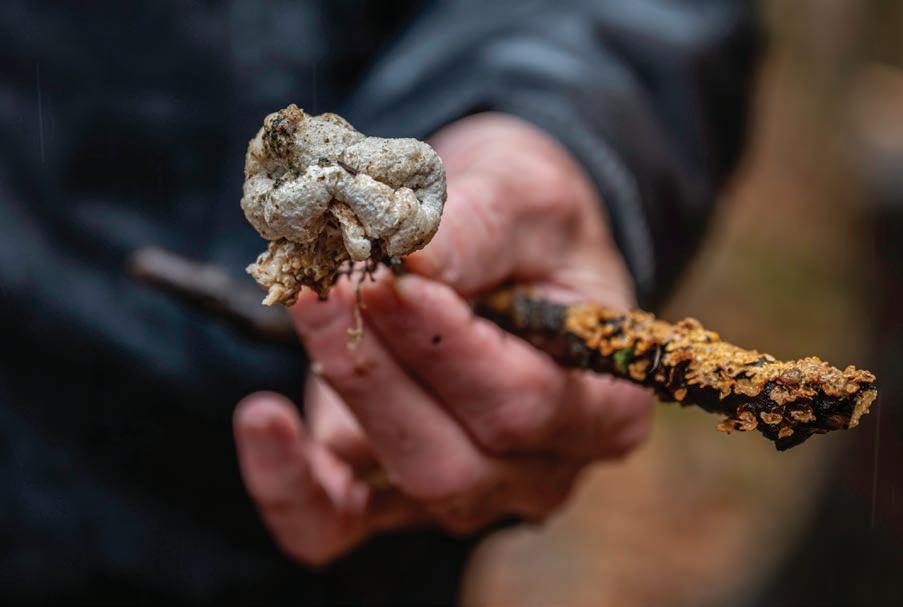
Managed by the Piedmont Land Conservancy, the Emily Allen Wildflower Preserve is a reminder that the natural world lies right at our feet.
In 1954, Allen and her husband, O. G., moved into the dream home they’d built on 6 acres of land — with a creek — in a leafy Winston-Salem neighborhood.
One spring, Allen noticed the purple-and-white petals of a wildflower emerging beneath what she described as “a mess with poison ivy, honeysuckle and blackberries growing everywhere” near the creek.
That wildflower was a showy orchid (Galearis spectabilis) and, somehow, it sparked a passion in Allen to learn everything she could about North Carolina native plants.
She took a botany class at Wake Forest University and went on to serve as president of the North Carolina Native Plant Society. Over some 40 years, Allen collected wild plants from the moun-
tains of Western North Carolina, nursing them in her backyard. Emily and O. G. donated their land through easement to the PLC in 2000. Since then, Allen’s care for what she always called her “Friendship Garden” has been bolstered by PLC staff and stalwart volunteers.
O. G. passed away in 2006 and Emily in 2015. Upon her death, their home was donated to the conservancy to be developed as an educational center.
Allen’s wildflower garden and house feature not just flowers from the mountains, but also a bounty of eastern North American trillium, along with native ferns, creeping phlox, Dutchman’s breeches, cranesbill geranium, flame azalea, Carolina buttercups, columbine, plus Oconee bells (Shortia galacifolia), a rare wildflower found in the southern Appalachian Mountains.
As you’d expect, the site is best known for its spring wildflower group tours, which are available by appointment only.
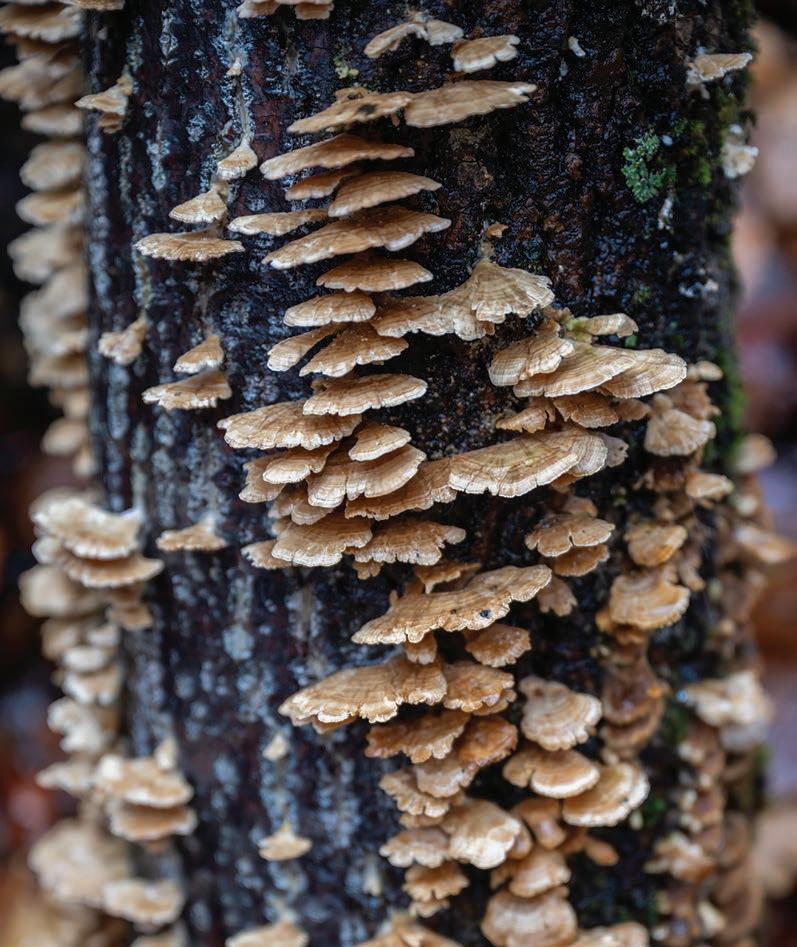
But photographer Lynn Donovan and I are here to participate in a fall “Mushroom Stroll,” one of several programs offered annually at the garden.
It’s raining steadily, and I should’ve given more thought to my outerwear. Veteran photojournalist Donovan has wisely brought a slicker and hood.
We’re greeted at the door by Janice Lancaster, manager of the garden. Lancaster received her undergraduate degree in dance from the University of North Carolina School of the Arts. In addition to her work with the PLC, Lancaster has developed a dance-ecology course at Wake Forest University and her choreog raphy often features environmental themes.
A group of mushroom strollers are already inside, as is Kenneth Bridle, who will lead our tour.
Bridle has a Ph.D. in biology from Wake Forest and has worked with the PLC for more than 30 years. Recently, he retired from his position as stew ardship director and now acts as a conservation adviser, leading nature walks and other activities.
Bridle’s career in environmental preservation is truly remarkable.
He is the author of several natural heritage inventories as well as rare plant and animal surveys. A ing member of the Dan River Basin Association, the Carolina Butterfly Society and the Triad Mushroom Club, he also teaches classes in a selective and rigorous Master Naturalists’ program that prepares volunteers to lead stewardship, educa tion outreach and citizen science projects.
Bridle gives us a quick tour of the improvements to the Allen house.
Bridle clears his throat.
“So, we’re going to wander around outside,” he announces to our group. “Everybody keep your eyes peeled.”
As we go outside, we can hear the steady drum of raindrops in the leaf canopy.
After a few steps along the path, Bridle pauses and points to the ground.

Split units now replace the original heating system. A downstairs bathroom was remodeled to serve as a wheelchair-accessible restroom.
“The last part is taking out cabinets and countertops in the old laundry room,” Bridle says. In their place, a catering kitchen will be installed.
“It’s slowly turning into more usable space, which is what Emily always wanted,” Bridle says.
He should know. He met Allen when he came to her garden as a graduate student.
That started a friendship that lasted for years. Bridle often served as Allen’s driver on her plant-collecting expeditions and, like her, Bridle would go on to serve as president of North Carolina Native Plant Society.
“After a hot, dry summer, we usually have some kind of rain event,” Bridle says, “and the following week, the mushrooms go crazy.”
“Right there, bird’s nest fungi,” he exclaims. Bird’s nest fungi e) are small, cup-shaped fungi containing spore-filled discs that resemble tiny eggs. The fungi feed on decomposing organic matter, such as wood and plant debris.
“When a drop of water falls in the nest,” Bridle says, “those spores blast out.”
He points out a dark mass spreading among leaves and sticks.
“That’s a whole colony of them,” he
A few more steps into the woods, we spy a tree trunk glistening in the rain. On its side are orange-colored growths with the texture and shape of oyster shells.
“That’s shelf fungi called orange crust,” Bridle says. “They come in many different
Shelf fungi have a tough exterior and are a favorite of mushroom enthusiasts because they can be observed year-round, even when other types of mush-
Bridle tells us that an unusual variety grows in the Blue Ridge Mountains, feeding on decaying rhododendrons.
“Those are iridescent blue and will glow in the dark,” he says. Farther along, we come upon more shelf fungi. These are called turkey tails. They’re nestled in groups along a rotting limb, bearing the shape and color of a tiny tom turkey displaying his tail feathers.
“They always have those nice, multicolored, concentric rings,” Bridle says. “And they have a long tradition in Asian medicine.”
As we make our way farther down the swale toward the creek, we come upon oyster mushrooms (Pleurotus ostreatus). Pale and serene, they’re edible, prized for their delicate texture and flavor.
“Of the mushrooms we find in the woods, the oysters are probably the most common,” Bridle says.
Nearby, Bridle points out another mushroom growing on a tree stump. It’s a resinous polypore ( family Fomitopsidaceae).
“See that orange resin?” he asks. “They produce that resin even in the driest of summers.” These mushrooms are perennials, producing a new ring of growth each year.
On a decaying log farther along the path, Bridle spots a small

specimen of an edible shelf mushroom. It’s called chicken of the woods ( genus Laetiporus) and can grow to be quite large, stacked in shelves, some 10 inches in width.
He tells us that the flesh of the mushroom is soft and tasty, and stores well wrapped in a paper bag and kept in the refrigerator. Vegans often prepare it as a substitute for meat, cooking it in a variety of ways.
“Anything you can do with a chicken finger you can do with chicken of the woods,” Bridle says.
He describes other fungi that are common to the area — hen of the woods, shrimp of the woods and lion’s mane.
“You’ll often find lion’s mane high up in a standing, dead tree,” Bridle says.
No excursion into the world of fungi is complete without at least one bizarre fact, and Bridle points out some beech trees growing on the other side of the creek.
“In September, I always take people down among those
trees,” he says, “because that’s where you’ll find the beech aphid poop-eater.”
Our group laughs nervously. Sometimes with a mycologist (a scientist who studies mushrooms), you wonder if they’re just pulling your leg.
Bridle explains that beech trees in September are hosts to colonies of beech blight aphids.
“We call them boogie-woogie aphids, because, if you tap on the tree branch, all the aphids do the wave.” That is, the aphids all at once start throbbing in unison.
See what I was saying about a mycologist?
These tiny insects suck sap from the beech trees, feeding on the sugar. Their excretions are politely referred to as “honeydew.”
So, on the limbs and leaves beneath the aphid colony, you’ll see masses of black fungus that look like sooty sponges.
That’s Scorias spongiosa, the beech aphid poop-eater.
“Everybody remembers that one,” Bridle concludes.

The rain is falling in earnest now, so even the well-equipped are ready to retreat. My barn coat feels like it’s holding about a gallon of water.
Donovan stows her camera gear and we get into the car.
We’re wet as bird dogs after a hunt. But we’re both grinning like crazy. High on mushrooms, you might say. And filled with wonder for the natural world. OH
For more information, visit www.piedmontland.org/preserves/emilyallen-wildflower-preserve/. There you’ll see a photograph of a bespectacled woman whose smile radiates joyfulness. That’s the late Emily Allen, seated at the heart of her garden in a bed of wild trilliums beneath a beech tree.
Ross Howell Jr. is a contributing writer. His wildlife garden in Blowing Rock is full of pollinators and a bachelor group of six white tail bucks that have scalped his oakleaf hydrangeas.


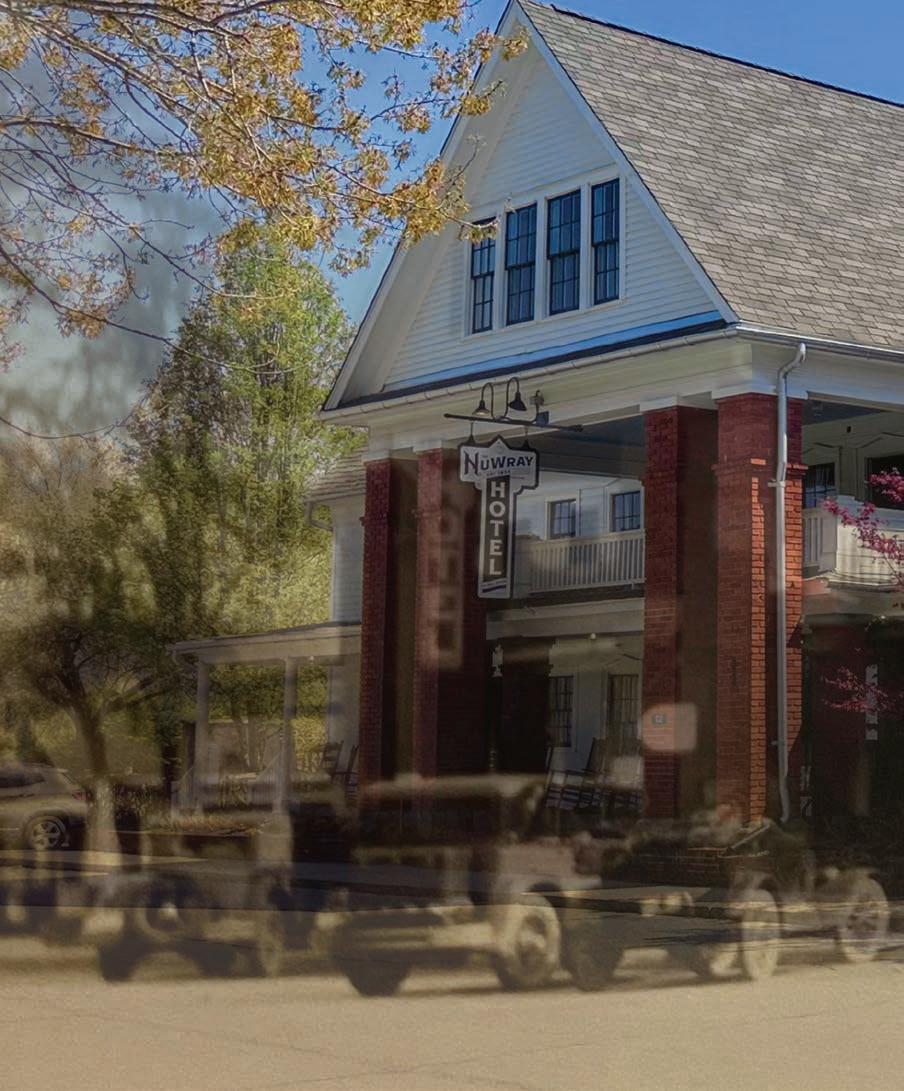
The
former owners of Double Oaks make their mark on North Carolina’s oldest hotel — the NuWray. Now, a new generation is discovering why Jimmy Carter, Mark Twain and Elvis all stayed here.
By Page leggett
When you pull into downtown Burnsville — a little mountain town (pop: 1,612) in Yancey County — you might think you’ve stumbled onto a movie set. Surely, some studio honcho ordered up the charming square complete with a historic inn and its rocking chair-filled front porches on two levels.
That’s the NuWray, North Carolina’s oldest continuously operating hotel.
The first time I saw it, while visiting the area for the twice-yearly Toe River Arts Studio Tour, it was closed for an overhaul. But I was captivated and knew I had to return.
The NuWray opened in 1833 as an eight-room log structure called Ray’s Hotel.
Owner Garrett Deweese Ray’s daughter, Julia, married William Brian Wray, and the couple inherited the hotel after Ray’s death in 1932. Locals began referring to the inn as the NuWray to distinguish it from its predecessor, the “Old Ray.”
The Wrays added the now-iconic stone fireplace in the lobby in the 1930s, although you’d swear it must’ve been there all along. The inn remained in the family for four generations before being sold in the 1990s, changing hands frequently and falling into disrepair.
That is, until an enterprising Greensboro couple intervened.
The ultimate DIYers.
Amanda and James Keith discovered a penchant for historic preservation while renovating a home in Greensboro. Their second renovation became the Double Oaks Bed & Breakfast, which they owned and operated from 2016 to 2024.

James is an electrician — among other things — who does much of the work himself.
Both the Keiths had full-time jobs while running their B&B: James was a music minister at First Presbyterian, and Amanda ran the Wake Forest University press. But both loved hospitality and went looking for a project that would allow them to be full-time innkeepers.
When they discovered the NuWray, it appeared down and out. But the Keiths were undaunted. The inn had “good bones,” as real-estate agents say of ramshackle properties.
And it had a pedigree.
“People from all over knew the NuWray in its heyday,” Amanda says. Jimmy Carter

and Elvis Presley stayed here. Christopher Reeve is rumored to have been a guest. And the NuWray has hosted so many writers — Mark Twain, Thomas Wolfe, O. Henry, F. Scott Fitzgerald — that Amanda was inspired to name one of the rooms “The Writer.”
But the inn’s biggest fans may be the people of Burnsville.
“If you ask just about any local, they’ll have a story,” Amanda says. “They worked here, their mother worked here, they had their wedding here. I don’t think there are many locals the NuWray hasn’t touched in some way.”
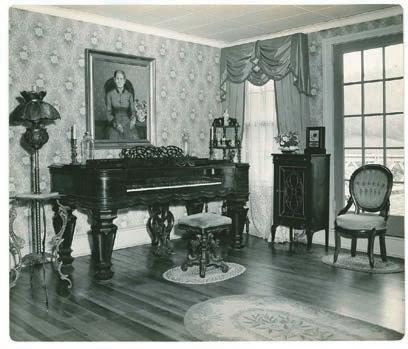
The Keiths bought the inn in October 2021, moved to Burnsville that December and started renovating in January 2022. They also bought the property adjacent to the inn and converted it into Carriage House Sundries, an art-filled coffee shop by day/wine bar by night with a humidor for cigar aficionados.
They wanted a big project, and they found it. “With historic properties, nothing is straightforward,” Amanda says. “You have to do a lot of it on the fly; you never know what you’ll find when you open up a wall.”
Amanda, who designed the interiors, found five layers of wallpaper in some places. “The wallpaper tells the story of the inn,” she says. Visitors can see preserved samples in several places.
The NuWray never had central air until the Keiths added it. They kept what furniture was usable, and Amanda scoured antique shops and Facebook Marketplace to source other pieces almost exclusively from the area.
The community was central to the restoration. Local crews worked on it, and, throughout the inn, you’ll see paintings by local artist Melissa Flattery and quirky lighting made from books, antique typewriters and other found objects by craftsman Ed Doyle.
When Amanda learned that a member of the Wray family, Joy Bennett, is a potter in town, she commissioned her to make ceramic name plates for each guest room.
In 1915, the Wrays started a restaurant, which really put the NuWray on the map, Amanda says. The Southern “country-cooking” recipes had been passed down through generations. Meals were served family-style.
“That’s difficult to pull off nowadays,” Amanda says. “The health department doesn’t particularly like it, and it’s wasteful.”
But the revamped restaurant, open for breakfast, supper and Sunday brunch, honors the NuWray’s history with updated recipes from the hotel’s historic cookbooks, such as “Will’s Sunday Cake” (custard-filled chocolate sponge cake with chocolate meringue frosting) and a “Smothered Salad” (mixed greens with warm bacon vinaigrette). Duck and dumplings, chicken-fried steak and a tomato tarte with goat cheese mousse are other standouts.

While James Keith was the chef at Double Oaks — what can’t he do? — the Keiths wanted someone with experience running a bigger kitchen for the 26-room hotel.
They lured Chef Peter Crockett to Burnsville from Asheville. “We really appreciate the environment he creates in the kitchen,” Amanda says. “He’s a strong leader and mentor. That was important to us because it helps attract and keep staff.”
The original smokehouse — now called Roland’s in honor of Will Roland, the hotel chef for over 40 years — serves al fresco drinks and snacks on Fridays and Saturdays from 4 to 10 p.m. The former laundry facilities in the basement are being converted into a bar with a speakeasy vibe.
The hotel reopened to much fanfare in August 2024. Just a few weeks later, on Sept. 27, Hurricane Helene tore through Western North Carolina. In its aftermath, the NuWray became a lifeline.
“Immediately after the storm passed, people began pouring into the square,” Amanda says. “No one had phone service, so this was the logical place to find out what was happening.
“Everyone was either looking for information or trying to pass information along. We started paper lists of what roads were passable, who’s missing, who’s looking for whom, what supplies are needed and where.” Those paper lists soon morphed into whiteboards.
The flooded restaurant was cleaned and the kitchen pressed into service. Townsfolk needed to be fed, and the NuWray needed to use stocked food before it went bad.
The staff of Carriage House Sundries, which had been open for almost a year, “showed up ready to help,” Amanda says. “Everybody jumped in and prepared what we could without electricity: sandwiches. We smoked all the meat we had in our fridges and freezers on our outdoor smoker, the Smok-O-Motive. Then, people started bringing their meat for us to cook.”
A 60 Minutes crew, including correspondent Sharyn Alfonsi, documented Helene’s devastation and the recovery efforts in
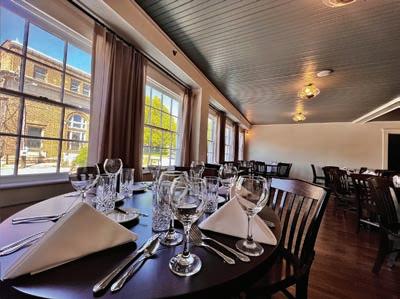
October 2024. Of course, they stayed at the NuWray.
The hotel reopened for a second time in May with a “Restoration Shindig,” a celebration of the hotel’s — and town’s — resilience.
“This wasn’t the opening season we pictured,” Amanda says, “but I’m grateful we got as far as we did before the storm hit. If we hadn’t, there’s no way we could’ve contributed what we did. And I think it’s so poignant that this is now part of the NuWray’s history. It’s been a beacon for a long time.”
Make your way to The NuWray. Learn more about Burnsville’s pride and joy and book a room at nuwray.com. The inn has 26 unique guest rooms with en-suite baths. Four are dog-friendly. There’s no elevator, but the inn has two first-floor guest rooms. OH

Page Leggett is a native North Carolinian and Wake Forest University alumna. She lives in Charlotte and writes on a variety of topics, including arts and culture, healthcare and travel. She especially loves back roads, small towns and gas station fried chicken. She’ll brake for estate sales and art festivals.
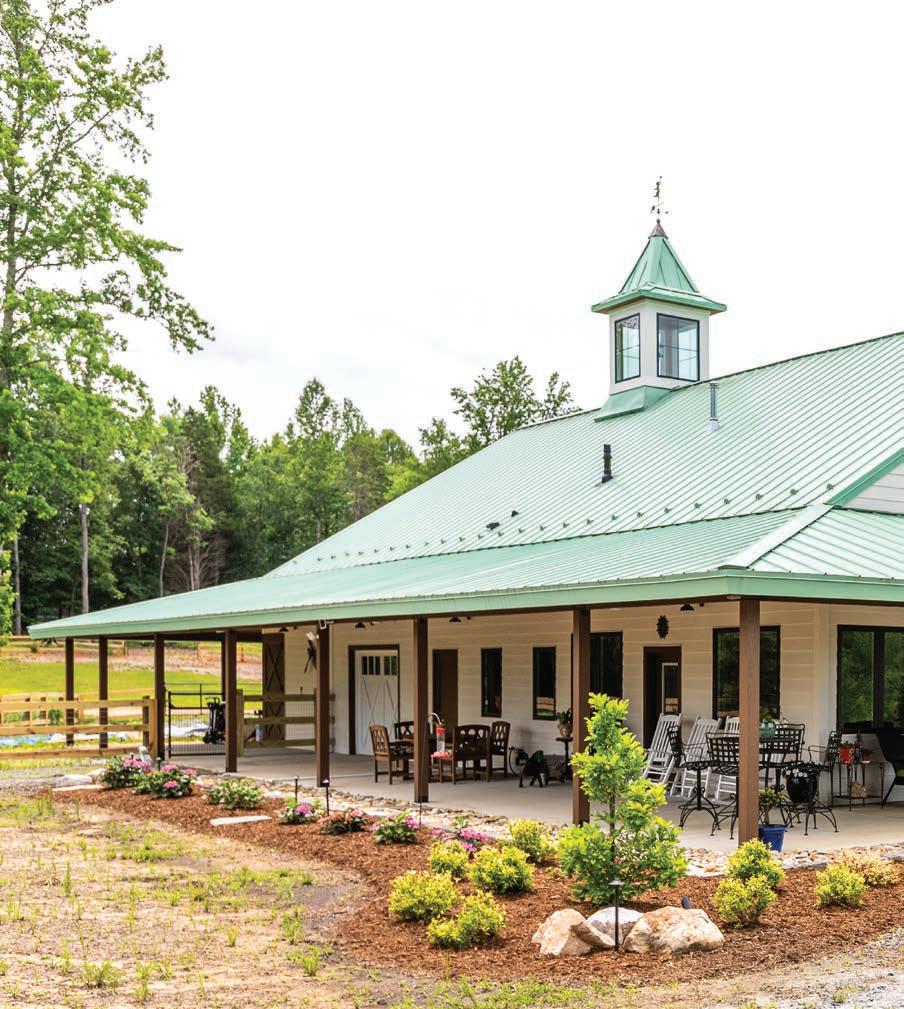
Terry Christian’s barndominium houses creatures great and small
By m aRia Johnson
gessneR


Last year, before the gated entrance was installed at Terry Christian’s new home, some neighbors drove up to the gleaming barn-like structure — the one that’s topped with a weathervane shaped like a dancing pig holding a martini glass — and asked, reasonably, if the building was a clubhouse provided by the homeowners’ association.
No, Terry explained. She was “in” the neighborhood, a freshly minted cul-de-sac community in Summerfield, but she was not “of” the neighborhood.
The wide-set building with a green, metal roof and deep wraparound porch was her private dwelling, she informed them.
She would share the hybrid house-barn with her horses, dogs, cats, a pig, a mini-donkey and other “Old MacDonald”-worthy
characters in her critter-based life.
Some of the neighbors thought it was cool.
Others thought it was “ew.”
Unbeknownst to both groups, they had crunched up the gravel driveway of a dream that hatched in Terry’s mind when she was an animal-loving girl growing up in Greensboro’s Old Starmount area in the 1960s.
Where did the dream come from?
Terry herself is not sure. Maybe she was influenced by Mister Ed, a TV sitcom that ran during her childhood. The show featured a horse that stuck his head through the top half of a Dutch door — very much like the portals in Terry’s barn — and conversed in voice-dubbed dialogue with his owner, Wilbur.
Maybe her dreams were genetic in nature, the combination

of her refined Southern mother’s compassion for the less fortunate, along with her father’s affinity for helping things grow and flourish.
Her dad, Dr. Joe Christian, was a well-known general practitioner in Greensboro. He was an avid gardener, too.
He imagined the city’s Bog Garden in 1987 while walking the family’s Boykin spaniel around the marshes near Northline Avenue and Holden Road. He appealed to landowner Blanche Sternberger Benjamin, widow of Friendly Center developer Edward Benjamin, to give the land to the city. The rest is wetland history.
That genealogy alone could explain Terry’s desire to live close to the land.
It’s also possible that her aspirations were totally unique, the sum of nature and nurture — plus more nature — including hours
spent playing in a creek and slogging home with lightning bugs in jars and frogs in her pockets.
Whatever the source of her dream, it took root.
And grew.
And now, nearly 60 years later, it has flowered.
“I finally get to have my passion,” Terry says.
Terry seems genuinely surprised that her pet pig, Hamlet, is caked with mud as he emerges from his dome-shaped “pigloo” in the side yard, snorting as he trots toward her with porcine purpose.
(Insert pig grunts here.)
“You are soooo dirty,” Terry coos to Hamlet.
(Grunts of acknowledgement.)


Indeed, Hamlet — a bristly, blond Vietnamese pot-bellied pig Terry bought as a piglet nearly 14 years ago — is not your average porker.
First, he cuts a svelte figure. For a pig.
Even the vet noticed.
“I’ve never said this before, but your pig is too skinny,” the vet told Terry, who is addressing the situation with supplemental puppy chow.
Second, Hamlet seems to engage in earnest conversation with Terry, who notices that he is favoring his right front hoof.
“What happened to your foot, little one?” she asks.
(Grunts of explanation.)
Terry watches and listens, as if making a diagnosis. She comes by that skill honestly.
Often, when her father, “Dr. Joe,” went on a house call for humans, young Terry — the third of four kids — tagged along. Sometimes, patients who were short on money paid her father in animals. Terry wanted to be there.
Finally, her mom said no more house calls for Terry, who was amassing a small zoo of cats, dogs, rabbits, a guinea pig and a duck named Donald, who imprinted on Terry.
“Wherever I went, that damn duck would follow me,” says Terry.
She wanted a pig and a monkey, too, but her parents said that pigs and monkeys would not fly, in any sense, in their home on Mistletoe Drive, a short suburban walk from the then-new Friendly Center.
She lobbied for a pony in the backyard. Her family gave her riding lessons at Gambolay Farm off Old Battleground Road.
Later, Terry got her own mount, a black horse named Tar Baby, who was stabled at Reedy Fork Ranch, off U.S. 29.
She, her sisters and their friends spent long hours at the farm, riding trails and getting into mischief with horses, hound dogs and barn snakes.
“I should have been a vet,” says Terry, “but I was more interested in cheerleading than chemistry.”
After graduating from Grimsley High School, she spent a year traveling with the nonprofit organization Up with People, a network of young musical troupes that sing and dance and otherwise exude positivity on stages around the world.
Terry’s casts traveled the U.S. in Greyhound buses, staying with host families and napping in hammocks strung up inside the buses.
“I was small enough to sleep on the luggage rack,” Terry says.
A talented alto, she loved being on stage. She earned degrees in theater and voice from UNCG. A friend lobbied her to move to New York and try Broadway.


But Terry stuck around Greensboro. She had found another love. She married Greg Johns and had two daughters, Austin and Anne-Christian.
She stayed in the public eye, too, by modeling, performing in community theater and acting in commercials, including those she wrote for her family’s business, Johns Plumbing.
To many, Terry had a picture-perfect life, including a sprawling estate in Summerfield, where she and her family maintained a 5,300-square-foot home and an 8,000-square-foot barn.
They kept horses plus peacocks, chicken, sheep and cows, and, for a while, a small vineyard with Sangiovese grapes.
Terry lived in fifth gear.
Then came 2020. Her eldest daughter, Austin, married. The pandemic hit. She and her husband split and sold the farm.
Terry moved in with her mother, by then a widow, who was happy to have the company.
Moving home at age 63 was strange for Terry.
She slept in her old bedroom.
“I kept thinking I should be sneaking out,” she quips.
Terry brought Hamlet and several of her chickens home to roost on Mistletoe Drive.
One day, she saw a Facebook post reporting a pig on nearby Madison Avenue.
Terry ran right over.
Another time, a neighbor reported a fox trotting down Mistletoe Drive with a white chicken in its mouth.
Something had to change.
Terry’s vision popped up again. What if she built her animal-filled dream home and took her mom with her?
Home design websites were full of barndominiums, a trend among rural-minded design buffs.
Terry made a list of architects.
Her lifelong friend, Laura Griffin, who had converted an old dairy barn in Wallburg into a chic bed-and-breakfast (see the Spring 2017 issue of O.Henry’s design-minded Seasons magazine), recommended Greensboro modernist architect Carl Myatt.
After one conversation with Myatt, who had tackled many challenging projects in his 60-plusyear career, Terry decided to look no further.
“Don’t laugh,” she instructed Myatt as she drew her dream floor plan with a crayon on a paper napkin.
She drew a rectangle with a line down the middle, short ways. Half barn. Half house. See?

Myatt listened. And asked questions.
Was she prepared to live with the smell of barn animals?
Terry assured him that she was obsessive about cleanliness and that smells would not be an issue.
What about the flies? Myatt asked.
I’ll hang pest strips, she answered. Land?
Working on it, Terry answered.
Intrigued, Myatt started sketching.
“I’d done barns, and I’d done houses, but I’d never connected them,” he says.
The final plan amounted to 3,000 square feet, split evenly between home and barn.
The human quarters include an open kitchen and living area plus space for a pottery studio, and two en suite bedrooms. The home would be a significant downsizing for Terry, but the space was all she needed or wanted.
The barn would have three stalls, a tack room and an equipment bay. The center aisle would be flooded with natural light streaming in from a custom-made cupola.
Myatt finished the plans.



Then everything froze.
COVID was still mucking with supply chains and the prices of construction materials. Terry waited for prices to fall and rejiggered financing.
Lenders wanted to know: Was the structure a house or a barn?
Yes, said Terry, who still owns part of the plumbing business.
Construction started in 2021 and sputtered along.
Terry’s mom moved to a memory care center in 2022.
“She knew it was time,” says Terry.
The residential part of the barndominium was finished in 2023, and Terry moved in without her mom.
Later that year, Anne “Annie B.” Christian died.
“Both she and Daddy are still here,” Terry says confidently. Many of her parents’ treasured objects surround her in her new place.
Her doctor-gardener-father, who was a talented sculptor as well, made a bust of Mark Twain. The caricature rests on a pedestal near the front door.
Nearby stands her mother’s upright piano, which Terry’s grand-


son, 2-year-old Forrest, brings to life when he visits.
Artwork by his 5-year-old sister, Bridger, splashes the space with energy.
With the help of designer Lou Walter of High Point, Terry brought polished warmth to her museum-like space, which is bound by high ceilings, white walls, banks of windows and a concrete floor.
Playing off exposed beams overhead, the duo grounded the kitchen and living area with bass notes of leather furniture, Oriental-style rugs, bronze artwork and pottery, some of which is by Terry’s own hand.
A hammered copper stove hood and dark, speckled, peacock granite countertops anchor the kitchen.
Greensboro artist Lisa Cox used her faux brushwork to add interest and depth to the concrete floor and a vintage table-turnedkitchen-island. She copied the kitchen’s subway tile backsplash in a
doorway leading to the barn, which was finished earlier this year. General contractor Earl Waddell applied his woodworking skills in the equine wing, finishing the interior with handsome tongue-in-groove, yellow-pine walls and doors.
The stalls received their first occupants, rescue mares Midnight and Cinnamon, in July.
Their luxury compartments include automatic watering troughs, rubberized floor mats, stylish wrought-iron hay racks and modern ceiling fans just out of reach of curious muzzles.
The third stall belongs to a mini-donkey, Faith.
“I want the place to be swarming with animals,” says Terry, who is well on her way to populating her hilltop ark.
Her housemates include a fiercely protective, 75-pound German shepherd, Xena, who is named after the Warrior Princess, as well as a Scottish Fold cat named Gabby and a Siamese-tabby, Taz.
Confident of having a few more lives, Taz spars with Xena on the rug at Terry’s feet.
Certain humans are welcome in this setting.
Terry envisions a nearby knoll as a possible future home for her grandchildren, who could traipse over the rise to YaYa’s house. A family compound on 22 acres, some of which skirt the Haw River, would suit Terry just fine.
She will add creatures as she sees fit.
Her green eyes flicker.
“I still want that monkey,” she says. OH







By a shley walshe
October is an ancient oak, quiet and delighted.
“Come, sit with me,” he whispers gleefully. “We’re nearly to the best part.”
Life starts all over again when it gets crisp in the fall. — F. Scott Fitzgerald
The air is ripe with mischief and mystery. Can you smell the soil shifting? Feel the seasons turning in your bones?
Come, now. Rest at the roots of the mighty oak. Press your back against the furrowed bark and listen.
Goldenrod glows in the distance. Blackgum and sourwood blush crimson. A roost of crows howls of imminent darkness.
“Of course,” breathes the oak, hushed and peaceful. “But the darkness only sweetens the light.”
As a swallowtail sails across the crisp blue sky, birch leaves tremble on slender limbs; a crow shrieks of wet earth and swan songs.
You close your eyes, feel the vibration of sapsucker rapping upon sturdy trunk.
“Do you feel that?” you ask the oak.
“I feel everything,” he murmurs.
When you open your eyes, the colors are different. The green has been stripped from poplar and maple, reds and yellows made luminous by the autumn sun.
At once, the great oak shakes loose a smattering of acorns.
“Watch this,” he softly chuckles, sending the gray squirrels scurrying.
A sudden rush of wind sends a shiver down your spine. Leaves descend in all directions, wave after fluttering wave, in kaleidoscopic glory.
The goldenrod is fading. The sunlight, too. The swallowtail, gone with the wind.

“Things are getting good now,” smiles the oak, his mottled leaves gently rustling.
You sense your own soil shifting. Feel the sweet ache of new beginnings. Let yourself drop into ever deepening stillness.
It’s winter squash season. As the autumn days shift from crisp to chilling, what could be sweeter — or more savory — than roasted delicata, cinnamon-laced and fork tender? Acorn squash tart with maple, ricotta and walnuts? Cream of squash soup (butternut or kabocha) served with a crispy hunk of sourdough?


And let’s not forget pumpkin (and pumpkin spice) mania. It’s all here. Enjoy!
Until the first frost arrives — weeks or days or blinks from now — delicate blossoms sway on tall, slender stems, brightening the garden with color and whimsy.
Hello, cosmos.
One of October’s birth flowers (marigold, the other), cosmos are said to symbolize harmony and balance, their orderly petals having inspired their genus name. Native to Mexico, this daisy-like annual thrives in hot, dry climes. It’s the traditional flower for a second wedding anniversary gift and, according to The Old Farmer’s Almanac, was once thought to attract fairies to the garden.
Could be true. Just look how the butterflies take to them. OH
A SPECIAL ADVERTISING SECTION
Improve your home and garden with help and inspiration from these local businesses

Blue Denim Real Estate
Boxwood Antique Market
Chelsea on Green
A Cleaner World
Compassionate Wildlife Removal
Craig McIntosh/Tyler RedHead McAlister
Crawlspace Medic
ETC for the Home
Five Star Painting
Flower Barre
Golden Oldies Antiques
Guilford Garden Center
Jaree Todd/Berkshire Hathaway HomeServices
Kitchen Express of Greensboro
Kitchen Tune-Up
Laura Redd Interiors
Leslie Stainback/Tyler RedHead McAlister
Murphy’s Upholstery
Paul Davis Restoration
Priba Furniture
Randolph County Tourism Development Authority
ReBath of the Triad
Seabolt Upholstery
A Shade Better
South 23rd
Stokesdale Marketplace
Sunbird Storage
Twin Brothers Antiques
WhiteStone
Window Works Studio


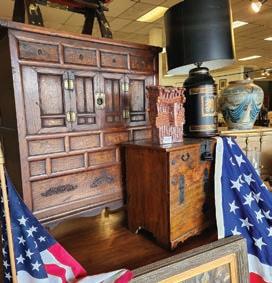



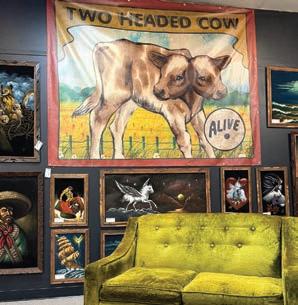
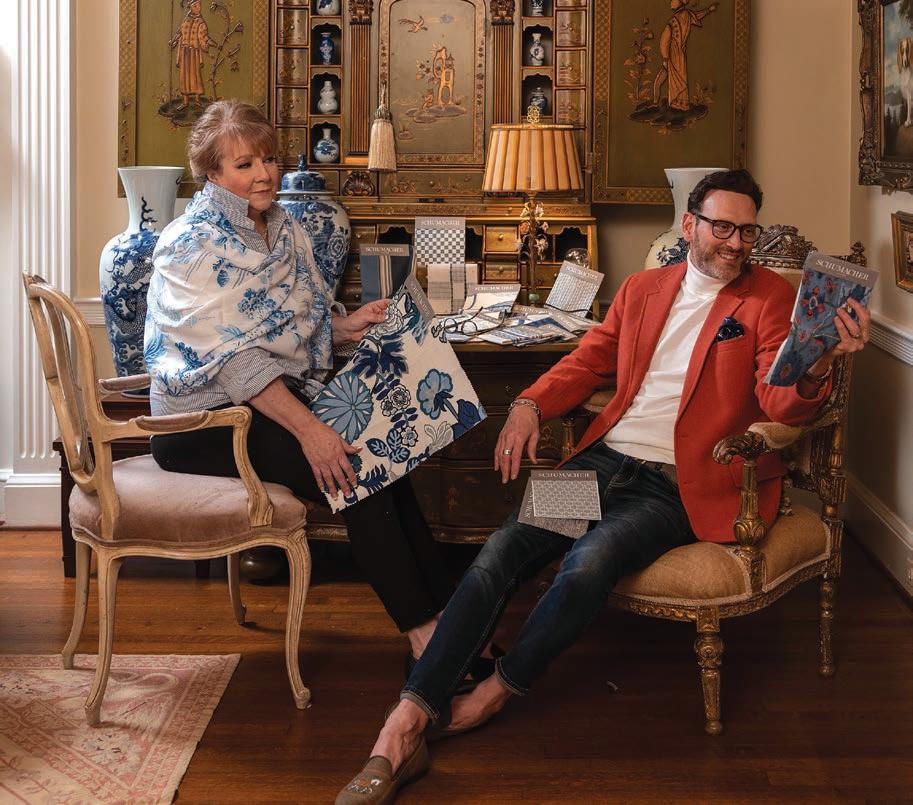






“Craig McIntosh is an amazing realtor! Truly helped me present my home in the very best light so that it sold very quickly for well above asking price! She goes above and beyond in making herself available for questions and help outside of normal working hours. Kept a remarkably cheerful disposition when dealing with a very difficult buyer and their realtor. Highly, highly recommend!’’



















It is my goal to ensure you find the right home or attract the right buyer - on your terms!

"Buying and selling real estate is more than a transaction — it’s a life change. My clients tell me I go above and beyond, listening to what truly matters and making the process clear and doable. For me, it’s about people first and the life they want to build — not just houses. I treat every client like a friend, and wherever you’re headed, I’m here for your next move.”
-Leslie




At The Jaree Todd Team, we’re thankful for the incredible Triad community we call home. This fall, we’re proud to support two organizations making a difference in the lives of others: Earlier.org & Gathering of Friends – leading the way in early detection of breast cancer
Jamestown Pig Pickin’ – benefiting Family Services of the Triad
Thank you for standing with us in supporting these wonderful causes.



310 w broad ave high point, nc 27262






Taking your space from ordinary to extraordinary! Elevated style for every home

Our patent-pending planter cover instantly upgrades any plastic pot into a design-forward accent. No repotting, no hassle - just slide it on and elevate your seasonal greenery in seconds
Available in multiple sizes and timeless prints, it’s the easiest way to bring designer polish to your patio, porch or balcony.




THE ROOTED MAGNOLIA – Greensboro, NC PINEAPPLE PORCH – Stokesdale, NC
Stop by, explore, and experience our products up close!










Kick off Fall 2025 by joining Seagrove Potters on the first two Saturdays in October in celebration of “American Craft Week”.
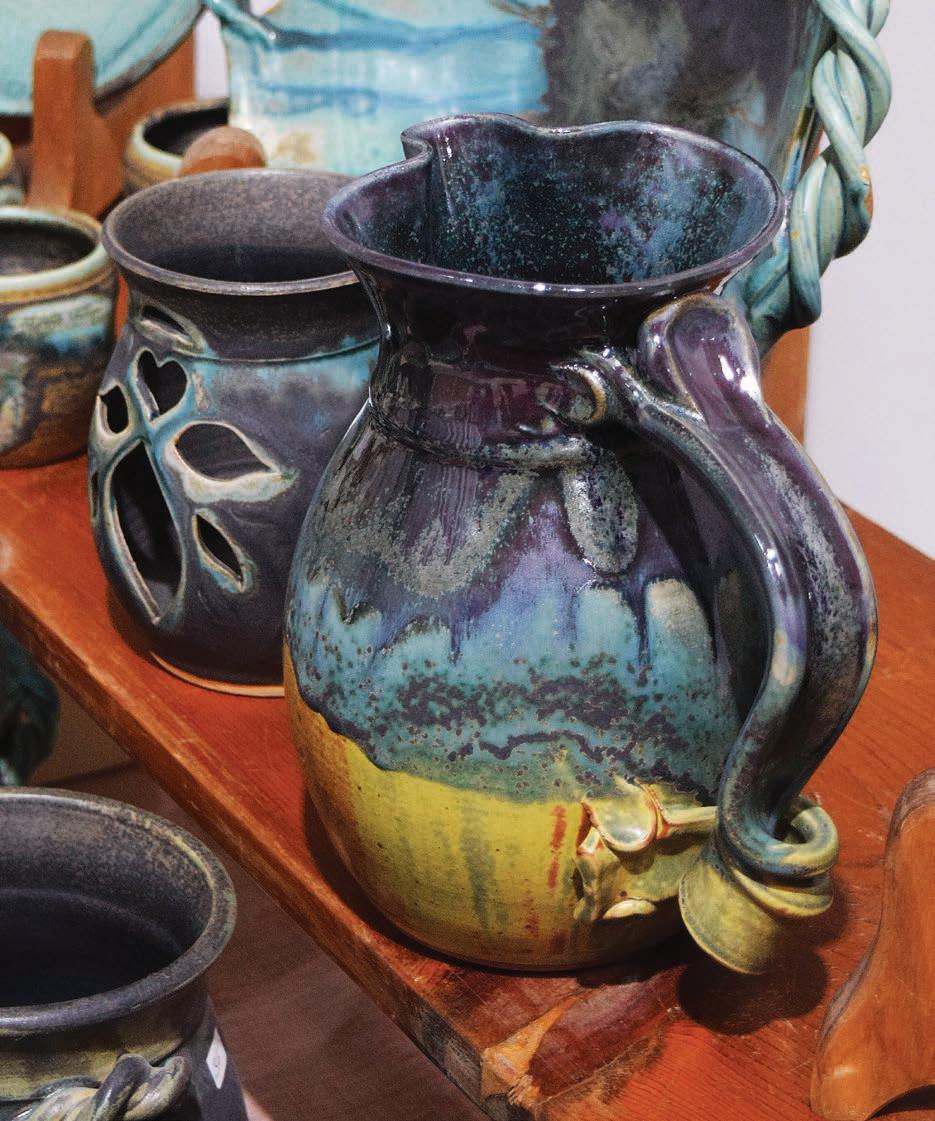
Find your perfect pottery pumpkin on the Potters’ Pumpkin Patch Trail along NC Pottery Highway 705, weekends, during the month of October at participating potters.
the
Get a head start on your holiday shopping and immerse yourself in the world of handcrafted artistry at the Seagrove Pottery Event Weekend, Saturday & Sunday, November 22nd & 23rd. It’s the perfect chance to find unique gifts, add to your own collection, and experience the rich tradition of Seagrove pottery in a festive, pre-holiday atmosphere. yourself

and
and



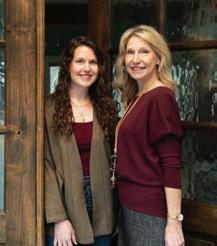


































At WhiteStone, home is more than a place – it’s where warmth, friendship, and purpose bloom. Our welcoming community is rooted in traditions of generosity and philanthropy, and designed to inspire your best life every day.
Just like a garden and nature itself, your lifestyle here will flourish in every season – whether you’re enjoying beautiful outdoor spaces, engaging in new hobbies, making new friends, or simply relaxing in the comfort of home. Call us today at 336-652-3415 to schedule your personal appointment. 700 S. Holden Road | Greensboro, NC 27407 liveatwhitestone.org








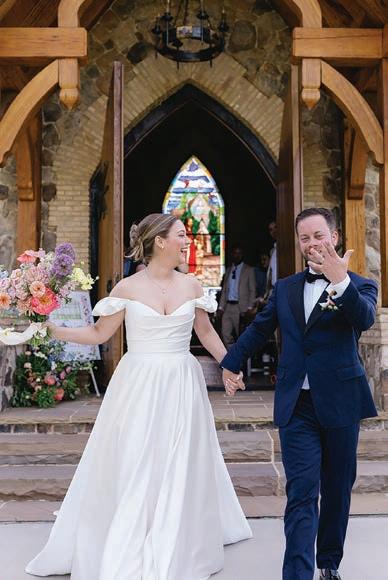
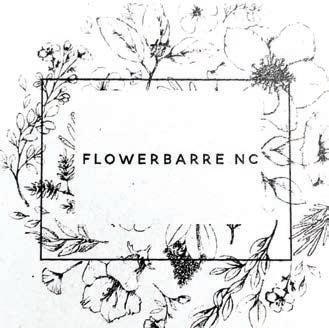


Before attending any event, it’s best to check times, costs, status and location. Although we conscientiously use the most accurate and up-to-date information, the world is subject to change and errors occur!
October 1–31
FIGHTERS FOR FREEDOM. Peruse paintings by Harlem Renaissance artist William H. Johnson created to pay tribute to African American activists. Free. Weatherspoon Art Museum, 500 Tate St., Greensboro. Info: weatherspoonart.org/exhibitions/ current-exhibitions.
TARA THACKER. Stroll through the artist’s 2D and 3D creations fabricated using ceramics and mixed media, on display in the brand-new Betty and Benjamin Cone Jr. Alcove Gallery. Free. GreenHill Center for NC Art, 200 N. Davie St., Greensboro. Info: greenhillnc.org/exhibitions.
MAKING CONNECTIONS. This installation of works from the Weatherspoon’s attic showcases the gallery as an academic museum with abiding connections to its campus, Greensboro and broader communities. Free. Weatherspoon Art Museum, 500 Tate St., Greensboro. Info: weatherspoonart.org/ exhibitions/current-exhibitions.
CONSTANT/CHANGE. Explore the works of eight emerging North Carolina artists in this juried exhibition. Free. GreenHill Center for NC Art, 200 N. Davie St., Greensboro. Info: greenhillnc.org/exhibitions.
PATTERN RECOGNITION. Explore the power of pattern in this exhibit featuring works from the Weatherspoon collection. Free. Weatherspoon Art Museum, 500 Tate St., Greensboro. Info: weatherspoonart.org/ exhibitions/current-exhibitions.
October 1–20
GLASS PUMPKIN PATCH. Take a stroll through and shop amidst a glimmering garden of more than 3,000 hand-blown glass gourds, pumpkins and seed pods created by Starworks artists. Free. Starworks, 100 Russell Drive, Star. Info: starworksnc.org/starworks-events.
October 1
READING THE WORLD. 7–8 p.m.
Discover and discuss contemporary authors’ works in translation, such as this month’s

Annual Downtown Greenway Community Picnic
October 26 • 4-6 p.m.
Carolyn Coleman Way and Martin Luther King Drive intersection
pick — The Art of Hearing Heartbeats by JanPhilipp Sendker — a haunting fable involving passionate love and an enchanting mystery set in Burma. Free. Online. Info: scuppernongbooks.com/events.
SHRINERS CIRCUS. 4 & 6:30 p.m. The Oasis Shrine Circus is full of tricks, twists and entertainment. Novant Health Fieldhouse at First Horizon Coliseum, 1921 W. Gate City Blvd., Greensboro. Info: gsocomplex.com/events.
October 2–5
ARTSTOCK. Thursday, 6:30–9 p.m.; Friday, 5–9 p.m.; Saturday & Sunday, noon–5 p.m.
After a Thursday evening kickoff party featuring a First Friday show at the Center for Visual Artists, spend the weekend touring through artist studios and pop-ups — from Greensboro into High Point — marked with red balloons and signs while shopping pottery, paintings, prints and various other mediums. Free. Greensboro and High Point. Info: artstock.com.
October 2
GALLERY PERFORMANCE. 6–7:30 p.m. Peruse through the art museum while the UNCG Latin American Folk Ensemble plays tunes that celebrate Afro-Latino composers. Free. Weatherspoon Art Museum, 500
Tate St., Greensboro. Info: weatherspoonart. org/calendar.
October 3–5
SWEENEY TODD. Times vary. UNCG theatre students take you on a musical journey down the dark, twisted streets of 19th-century London — where revenge is served piping hot. Tickets: $5.49+. UNCG Auditorium, 408 Tate St., Greensboro. Info: vpa.uncg.edu/events.
October 3–4, 10–11
SWEET MEDICINE. 7 p.m. This one-woman show performed by Sage Chioma combines poetry, storytelling, movement and visual imagery to create a deeply transformative experience that promises to be “an Elixir of Hope and Healing.” Tickets: $15+. Stephen D. Hyers Theatre at the Greensboro Cultural Center, 200 N. Davie St., Greensboro. Info: greensboro-nc.gov/departments/ creative-greensboro.
October 3
FIRST FRIDAY. 6–9 p.m. Head downtown for a night of live music and happenings stretching all the way from LeBauer Park and the Greensboro Cultural Center to the South End. Free. Downtown Greensboro. Info: downtowngreensboro.org/first-friday.
FIRST FRIDAY STORYTIME. 10–11:00 a.m. Bring your young children outside to enjoy engaging books, playful movement and cheerful songs with a member of the Youth Librarians team from Greensboro Public Library. The first 15 families can snag a free book courtesy of Ready for School, Ready for Life and The Basics Guilford. Free. Woven Works Park, 401 Cumberland St., Greensboro. Info: downtowngreenway.org/ events.
ALI SIDDIQ. 7 p.m. Called stand-up comedy’s most prolific storyteller by Vulture, the comic whose career began behind bars hits the stage. Tickets: $47.90+. Steven Tanger Center, 300 N. Elm St., Greensboro. Info: tangercenter.com/events.
WHEATUS. 8 p.m. Calling all “Teenage Dirtbags” for an acoustic performance featuring Gabrielle Sterbenz. Tickets: $22.60+. Flat Iron, 221 Summit Ave., Greensboro. Info: flatirongso.com/events.
October 4–5
COMIC CON. 10 a.m. Big Lick Comic Con blends culture, entertainment and positivity over two unforgettable days filled with exhibitors, artists, cosplay, gaming, vendors and even special guests Lou Ferrigno, Catherine Sutherland and Nakia Burrise. Tickets: $19.37+. First Horizon Coliseum, 1921 W. Gate City Blvd., Greensboro. Info: gsocomplex.com/events.
BAKED CLAY & ROASTED TURKEY. 10 a.m–5 p.m. Nosh on “turkey jerky” and enjoy demonstrations while perusing the kiln opening of R.D. Mahan, honoring the potter’s father and namesake, Ronald Dewitt Mahan. Free. From the Ground Up Pottery, 172 Crestwood Road, Robbins. Info: fromthegrounduppots.com/new-events.
October 4, 11, 25
LIVE MUSIC. 6:30 p.m. Enjoy live music from an array of artists including Big Dumb Hick, BCR and Tony Low. Free. Starworks Cafe & Tap Room, 100 Russell Drive, Star. Info: starworksnc.org/starworks-events.
October 4
WESTERWOOD ART & SOLE. 10 a.m.–5 p.m. Take a walk through historic Westerwood while visiting open artist studios and perusing pieces to potentially take home. Free. Westerwood neighborhood, Greensboro. Info: westerwoodneighborhood. com/art-sole.
SYMPHONY OPENING NIGHT. Violinist Aubree Oliverson opens the season with the Greensboro Symphony’s performance
of Beethoven’s Fifth. Tickets: $44.10+. Steven Tanger Center, 300 N. Elm St., Greensboro. Info: tangercenter.com/events.
CINDERELLA. 3 p.m. The glass slippers have been replaced with ballet shoes for this Broadway-style production of the fairytale classic performed by World Ballet Company. Tickets: $45+. Carolina Theatre, 310 S. Greene St., Greensboro. Info: carolinatheatre.com/events.
THE FAMILY REUNION. 7 p.m. The Daniel Barksdale stage play touches on something every family has — drama. Tickets: $53.90. Odeon Theatre at First Horizon Coliseum, 1921 W. Gate City Blvd., Greensboro. Info: gsocomplex.com/events.
FALL FEST. 9 a.m.–5 p.m. Enjoy raptor bird presentations from 10 a.m.–1 p.m. and live music by Justin Reid from 1:30–3:30 p.m. while noshing on grub from Rebel Chef food truck. Free. Guilford Garden Center, 3811 Lawndale Drive, Greensboro. Info: guilfordgardencenter.com/ events-at-guilford-garden-center.
October 5–6
MYTH & MYSTICS. 3:30 p.m., Sunday; 7:30 p.m., Monday. Tickets: $5+. This Choral Arts Collective concert explores fables, legends and tales told throughout history. Ebenezer Lutheran Church, 1900 Walker St., Greensboro. Info: choralartscollective. org/events.
October 5
ART IN THE ARBORETUM. 1–5 p.m. Peruse artisan-made wares and works while strolling through lush, fall gardens. Free. Greensboro Arboretum, 3299 Starmount Drive, Greensboro. Info: greensborobeautiful.org.
October 7
SYMPHONIC BAND. 7:30–9 p.m. Dr. Stephanie Ycaza, UNCG professor or tuba and euphonium, joins the UNCG Symphonic Band for a concert featuring the works by Kevin Day, Ivette Herryman Rodríguez, Norman Dello Joio, Gala Flagello, Drew Bonner and Dmitri Shostakovich. Free. UNCG Auditorium, 408 Tate St., Greensboro. Info: vpa.uncg. edu/events.
October 8
SYMPHONY ORCHESTRA. 7:30–9 p.m. Enjoy an evocative program featuring Rimsky-Korsakov’s Capriccio espagnol and Respighi’s stately tone poem, Pines of Rome. Plus, Professor Marjorie Bagley and Dr. Scott Rawls perform Mozart’s grand “Sinfonia Concertante” with the orchestra.
Free. UNCG Auditorium, 408 Tate St., Greensboro. Info: vpa.uncg.edu/events.
PLAYWRIGHTS FORUM. 7–9 p.m. Meet with other creative individuals to workshop your own scripts and follow creative monthly assignments. Membership: $40/year. Greensboro Cultural Center, 200 N. Davie St., Greensboro. Info: greensboro-nc.gov/ departments/creative-greensboro.
MURDER MYSTERY. 6–8 p.m. Immerse yourself in an interactive whodunnit experience while enjoying delicious bites from JJ’s Cuban Kitchen. Tickets: $40. Guilford Garden Center, 3811 Lawndale Drive, Greensboro. Info: guilfordgardencenter.com/ events-at-guilford-garden-center.
October 9, 14, 16, 21
DO YOU LIKE SCARY MOVIES? 7 p.m. The Nightmare Off Elm Street series of movies features four frightening flicks kicked off by Scream. Tickets: $9+. Carolina Theatre, 310 S. Greene St., Greensboro. Info: carolinatheatre.com/events.
October 9
ARTISTS PANEL. 6–7:30 p.m. In this dynamic discussion moderated by Creative Greensboro’s community partnerships coordinator, Karen Archia, Greensboro artists respond to the work of William H. Johnson. Free. Weatherspoon Art Museum, 500 Tate St., Greensboro. Info: weatherspoonart.org/ calendar.
HUB NEW MUSIC. 7:30–9 p.m. The UNCG wind ensemble is joined by trailblazers Hub New Music and composer Gala Flagello. Free. UNCG Auditorium, 408 Tate St., Greensboro. Info: vpa.uncg.edu/events.
HOT GLASS, COLD BEER. 5:30 p.m. Enjoy glass blowing demonstrations while grooving to live music, sipping craft beers and noshing on food truck fare. Tickets: $5. Starworks, 100 Russell Drive, Star. Info: starworksnc. org/starworks-events.
October 10–12
GROUNDHOG DAY. Times vary. In this humorous musical based on the movie of the same name, every day is Groundhog Day. Tickets: $26+. High Point Theatre, 220 E. Commerce Ave., High Point. Info: highpointtheatre.com/events.
SWEENEY TODD. Times vary. The musical thriller featuring the music and lyrics of Stephen Sondheim tells the scary story of The Demon Barber of Fleet Street. Tickets: $18+. Van Dyke Performance Space at the Greensboro Cultural Center, 200 N. Davie St., Greensboro. Info: summerfieldstage.com.
October 10–11
AGGIE HOMECOMING. Times vary. Enjoy two days of concerts and performances to celebrate NC A&T State’s “Greatest Homecoming on Earth.” Tickets: $39.60+. Greensboro Coliseum, 1921 W. Gate City Blvd., Greensboro. Info: greensborocoliseum. com/events.
October 10
NURSE JOHN. 7 p.m. This nurse turned comedian knows that laughter is the best medicine. Tickets: $52.80+. Steven Tanger Center, 300 N. Elm St., Greensboro. Info: tangercenter.com/events.
WHISKEY MYERS. 6:30 p.m. Enjoy an evening of Texas-made American rock and roll. Tickets: $46+. White Oak Amphitheatre, 1403 Berwick St., Greensboro. Info: gsocomplex.com/events.
October 11
ART CRAWL. 10 a.m.–5 p.m. In this interactive art crawl that allows you to connect with local artists, the themes of current exhibit Fighters for Freedom are brought to life. Free. Info: weatherspoonart.org/calendar.
ALEXANDRA KAY. 8 p.m. The social media
sensation and American Idol contestant shows off her singing chops to the stage. Tickets: $45.80+. Piedmont Hall, 1921 W. Gate City Blvd., Greensboro. Info: gsocomplex.com/ events.
FALL HARVEST. Noon–4 p.m. Whether brining, smoking or pickling, learn all about preserving foods of the harvest from costumed interpreters. Free. Historical Park at High Point Museum, 1859 E. Lexington Ave., High Point. Info: highpointmuseum.org.
October 12
ANDREA BOCELLI. 8 p.m. The legendary tenor who is one of the bestselling classical solo artists in history delivers a moving performance. Tickets: $116.60+. First Horizon Coliseum, 1921 W. Gate City Blvd., Greensboro. Info: gsocomplex.com/events.
JAZZ WORKSHOP. 2–3:30 p.m. All levels of musicians are welcome to listen, discuss and jam with other musicians while learning technique. Free. The Music Academy of North Carolina, 1327 Beaman Place, Greensboro. Info: musicacademync.org.
October 15
BETHEL MUSIC. 7 p.m. Enjoy a night of




music and ministry all wrapped into one. Tickets: $52.55+. Steven Tanger Center, 300 N. Elm St., Greensboro. Info: tangercenter. com/events.
October 16
KANSAS. 7:30 p.m. In its 51st year of musicmaking, the band that brought you “Carry on Wayward Son” is joined by Blue Oyster Cult for a rocking evening. Tickets: $63.35+. Steven Tanger Center, 300 N. Elm St., Greensboro. Info: tangercenter.com/events.
AUTHOR TALK. 6–7 p.m. Margaret Hutton discusses her debut novel, If You Leave — an intimate, immersive story exploring motherhood, love and art — with journalist and author Katherine Snow Smith. Free. Scuppernong Books, 304 S. Elm St., Greensboro. Info: margarethutton.com/events-1.
October 17–19
DUNGEONS & DRAGONS. Times vary. The fantasy role-playing game takes the stage live in The Twenty-Sided Tavern for an experience that Nerdist calls “rip-roaring funny.” Tickets: $46.90+. Steven Tanger Center, 300 N. Elm St., Greensboro. Info: tangercenter. com/events.


October 17
COUNT BASIE ORCHESTRA. 8 p.m. As part of the UNCG Concert & Lecture Series, the 18-time Grammy-winning ensemble featuring some of jazz’s greatest soloists performs. Tickets: $7.50+. UNCG Auditorium, 408 Tate St., Greensboro. Info: vpa.uncg.edu/events.
ROARING ’20S SPEAKEASY NIGHT. 6:30–9:30 p.m. Enjoy a swell evening of jazz, cocktails, heavy hors d’oeuvres and razzmatazz, including a scavenger hunt, games and contests that evoke the spirit of the 1920s. Tickets: $33.85+. Greensboro History Museum, 130 Summit Ave., Greensboro. Info: greensborohistory.org/events.
LESSONS FOR LIFE GALA. 7 p.m. Dress in your cocktail best and enjoy heavy hors d’oeuvres, brews and live performances courtesy of the Music Academy of North Carolina’s faculty and merit scholarship students. This gala raises funds so that the academy can increase access to music education. The Colonnade at Revolution Mill, 900 Revolution Mill Drive, Greensboro. Info: musicacademync.org/lessons-for-life-gala.
THE STRING QUEENS. 7:30 p.m. This dynamic trio treats the audience to a stirring musical performance featuring music from across the ages and genres. Tickets: $25+. Carolina Theatre, 310 S. Greene St., Greensboro. Info: carolinatheatre.com/events.
BRANDON LAKE. 7 p.m. Enjoy an evening of contemporary Christian worship music including special guests Franni Cash and Pat Barrett. Tickets: $57.45+. First Horizon Coliseum, 1921 W. Gate City Blvd., Greensboro. Info: gsocomplex.com/events.
October 18–19, 24–25
GARGOYLES. Times vary. Kick off Greensboro’s very own ice hockey team’s first season by cheering them on from the stands. Tickets: $52+. First Horizon Coliseum, 1921 W. Gate City Blvd., Greensboro. Info: gsocomplex.com/events.
October 18–19
THEATRE FOR ALL. 3–5 p.m. This show is the culmination of Theatre for All, a program that provides a safe and accessible environment for individuals with disabilities to express their creativity and grow their performance and social skills. Tickets: $15. Congregational United Church of Christ, 400 W. Radiance Drive, Greensboro. Info: triadprideperformingarts.org.
October 18
FALL GARDENING SEMINAR. 10 a.m.–4 p.m. The Greensboro Council of Garden
Clubs invites you to learn from experts: garden curator Adrienne Roethling, beekeeper Margaret Pike and landscape designer Christina Larson. The Sail Room at the Greensboro Science Center, 4301 Lawndale Drive, Greensboro. Registration: $20; BYO lunch or pre-order a $10 boxed lunch by Oct. 15. Info and reservations: call 336-580-6617 or 336-854-0408.
MEN CAN COOK. 5:30–8:30 p.m. At this Women’s Resource Center annual fundraiser, treat your senses to dishes made by men who are famous chefs in their own kitchens. Enjoy live entertainment, pose in a photo booth and sip small-batch wine, beer and spirits. Tickets: $50+. Piedmont Hall, 1921 W. Gate City Blvd., Greensboro. Info: womenscentergso.org/men-can-cook.
NC DANCE FESTIVAL. 7:30 p.m. Enjoy a performance featuring six works exploring themes involving poetry and technology, narratives and ancestry, the raw truths of lived experience and the quiet power of imagination. Tickets: $13.35+. Van Dyke Performance Space at the Greensboro Cultural Center, 200 N. Davie St., Greensboro. Info: danceproject.org/ncdf.
GHOST STORIES. 6–7:30 p.m. Following a half-hour of snacks and crafts, professional storyteller Donna Washington will tell spooky (but not too particularly scary) tales for the young and old. Free. Historical Park at High Point Museum, 1859 E. Lexington Ave., High Point. Info: highpointmuseum.org.
October 19
SUNDAY OPENING. Noon–5 p.m. In celebration of the Fighters for Freedom exhibit, the museum opens its doors on a Sunday, featuring informal panel discussions and refreshments. Free. Weatherspoon Art Museum, 500 Tate St., Greensboro. Info: weatherspoonart. org/calendar.
October 20
GEORGE FU. 7:30–9 p.m. The American pianist presents Olivier Messiaen’s complete Vingt Regards sur l’Enfant Jésus. Free. Tew Recital Hall, 100 McIver St., Greensboro. Info: vpa.uncg.edu/events.
ROBBIE FULKS. 7:30 p.m. Take a “Bluegrass Vacation” with this singer-songwriter for the evening. Tickets: $28. Flat Iron, 221 Summit Ave., Greensboro. Info: flatirongso.com/events.
SINGER-SONGWRITER SERIES. 7:30 p.m.



Abigail Dowd invites you to discover the music of Wes Collins and Ordinary Elephant. Tickets: $13.96+. Flat Iron, 221 Summit Ave., Greensboro. Info: flatirongso.com/events.
October 21–31
DÍA DE LOS MUERTOS ALTAR DISPLAY. Celebrate and learn about the Day of the Dead, a Latin American holiday that originated in Mexico and celebrates loved ones we have lost. Free. High Point Museum, 1859 E. Lexington Ave., High Point. Info: highpointmuseum.org.
October 22
JAZZ NIGHT. 6:30 p.m. Sip brews and munch on tasty eats while tapping your feet to Soul Noises. Free. Starworks Cafe & Tap Room, 100 Russell Drive, Star. Info: starworksnc.org/starworks-events.
October 23–26
THE LION, THE WITCH AND THE WARDROBE. 7 p.m., Thursday–Saturday; 2 p.m., Sunday. The C.S. Lewis children’s novel comes to life in a magical stage play. Tickets: $10. Van Dyke Performance Space at the
Greensboro Cultural Center, 200 N. Davie St., Greensboro. Info: greensboro-nc.gov/ departments/creative-greensboro.
October 23
ARTIST TALK. 6–7 p.m. Tara Thacker discusses her work, which layers ceramic and mixed-media pieces to transform material into richly textured abstractions and delicate wing-like forms. Free. Betty and Benjamin Cone Jr. Alcove Gallery, GreenHill Center for NC Art, 200 N. Davie St., Greensboro. Info: greenhillnc.org/exhibitions.
TWILIGHT IN CONCERT. 7:30 p.m. Experience the legendary, vampiric, romantic saga on the big screen as a live band provides the soundtrack amidst the glow of candlelight. Tickets: $48.70+. Steven Tanger Center, 300 N. Elm St., Greensboro. Info: tangercenter.com/events.
SAM BUSH. 7:30 p.m. The American mandolinist and International Bluegrass Music Hall of Famer who is considered to be an originator of contemporary bluegrass hits the stage. Tickets: $30+. Carolina Theatre, 310 S. Greene St., Greensboro. Info: carolinatheatre.com/events.

IN THIS MOMENT. 6:30 p.m. Tune into a night of heavy metal, including special guests Dayseeker and The Funeral Portrait. Tickets: $70.60+. Special Events Center at First Horizon Coliseum, 1921 W. Gate City Blvd., Greensboro. Info: gsocomplex.com/events.
ZACH TOP. 8 p.m. Raised on classic country music on the family farm, this Washington state native is joined by special guest Andy Buckner. Tickets: $71.40+. First Horizon Coliseum, 1921 W. Gate City Blvd., Greensboro. Info: gsocomplex.com/events.
October 24
TELL ME LIES. 7 p.m. Players only love you when they’re playin’ Fleetwood Mac songs at a tribute concert like this one. Tickets: $29+. Carolina Theatre, 310 S. Greene St., Greensboro. Info: carolinatheatre.com/ events.
October 25
STARWORKS ANNUAL BENEFIT & AUCTION. 11 a.m.–4 p.m. Raise a glass to craft and connection, while enjoying live entertainment, a delicious luncheon, a silent auction, and a stunning “Maker’s Dozen” live auction, showcasing 13 specially curated













october calendar
works of art. Tickets: $150+. Starworks, 100 Russell Drive, Star. Info: starworksnc.org/ starworks-events.
MAC BARNETT. 10 a.m. The National Ambassador for Young People’s Literature stops in Greensboro, sharing his passion for picture books with children and adults alike. Each child in attendance will receive a free Mac Barnett book. Free, registration strongly encouraged. Harrison Auditorium at N.C. A&T State University, 1009 Bluford St., Greensboro. Info: greensborobound.com/ events/list.
COLLAGE. 7:30–9 p.m. Get in the spooky spirit with special lighting, haunting music and non-stop scintillating performances by UNCG School of Music students and faculty. Tickets: $8+. UNCG Auditorium, 408 Tate St., Greensboro. Info: vpa.uncg.edu/events.
UNLIVING HISTORY. 2:30–5:30 p.m.
Geared towards children 12 and under, Ghoulash is an annual fall festival with costumed interpreters and Halloween-themed activities. Free. LeBauer Park, 200 N. Davie
St., Greensboro. Info: greensborohistory.org/ events.
TAYLOR SWIFT TRIBUTE SHOW. 7:30 p.m. Sing along as a live band plays selections from across the eras. Tickets: $40.10+. Steven Tanger Center, 300 N. Elm St., Greensboro. Info: tangercenter.com/events.
BOARD GAMES. 10 a.m.–4:30 p.m. Bring a blanket or snag a seat on a picnic table while costumed interpreters teach old-timey card and board games. Free. Historical Park at High Point Museum, 1859 E. Lexington Ave., High Point. Info: highpointmuseum.org.
October 26
COMMUNITY PICNIC. 4–6 p.m. Fresh air, delicious food, live music and community connection — the annual Downtown Greenway Community Picnic has it all. Tickets: $10+. Carolyn Coleman Way and Martin Luther King Drive intersection, Greensboro. Info: downtowngreenway.org/ events.
October 27




ROMANCE BOOK CLUB. 7 p.m. Romance is not dead — it’s alive and well at Scuppernong Books’ monthly online book club, where this month’s selection is Last Call at the Local by Sarah Grunder Ruiz. Free. Info: scuppernongbooks.com/events.
October 28–31
THE WIZ. Times vary. Touring for the first tim in 40 years, this Broadway twist on The Wizard of Oz hits the stage in a tornado of dance and song. Tickets:48+. Steven Tanger Center, 300 N. Elm St., Greensboro. Info: tangercenter.com/events.
October 31
SILENT FILM. 7 p.m. With its distorted set and twisted narrative, The Cabinet of Dr. Caligari is a cornerstone of horror and German Expressionism, magnified by a live organ music accompaniment. Tickets: $15. Carolina Theatre, 310 S. Greene St., Greensboro. Info: carolinatheatre.com/ events.

WEDNESDAYS
LIVE MUSIC & PAINTING. 6–9 p.m. Evan Olson and Jessica Mashburn of AM rOdeO play covers and original music while artist-inresidence Chip Holton paints. Free. Lucky 32. 1421 Westover Terrace, Greensboro. Info: lucky32.com.
FAMILY NIGHT. 5–7 p.m. Enjoy an artdriven evening with family and friends in the studios. Free. ArtQuest at GreenHill Center for NC Art, 200 N. Davie St., Greensboro. Info: greenhillnc.org/events.
MUSIC IN THE PARK. 6–8 p.m. Sip and snack at LeBauer Park while grooving to local and regional artists. Free. Lawn Service, 208 N. Davie St, Greensboro. Info: greensborodowntownparks.org/calendar.
THURSDAYS
JAZZ AT THE O.HENRY. 6–9 p.m. Sip vintage craft cocktails and snack on tapas while the O.Henry Trio performs with
a different jazz vocalist each week. Free. O.Henry Hotel Social Lobby, 624 Green Valley Road, Greensboro. Info: ohenryhotel. com/o-henry-jazz.
THURSDAYS & SATURDAYS
KARAOKE & COCKTAILS. 8 p.m. until midnight, Thursdays; 9 p.m. until midnight, Saturdays. Courtney Chandler hosts a night of sipping and singing. Free. 19 & Timber Bar at Grandover Resort & Spa, 1000 Club Road, Greensboro. Info: grandoverresort. com.
FRIDAYS & SATURDAYS
LIVE MUSIC. 7–10 p.m. Enjoy drinks in the 1808 Lobby Bar while soaking up live music provided by local artists. Free. Grandover Resort & Spa, 1000 Club Road, Greensboro. Info: grandoverresort.com.
SATURDAYS
POTTERS’ PUMPKIN PATCH. Take a self-guided tour through five artist galleries featuring unique fall-themed ceramics along

Seagrove’s Pottery Trail. Free. Seagrove, NC. Info: potterspumpkinpatch.com.
HISTORIC WALKING TOURS. 1 & 5 p.m. Take a guided walking tour through the history of downtown Greensboro at 1 p.m. or, if you’re into true crime, stroll through The Gate City’s darker side, covering 1953–1997, at 5 p.m. Tickets: $14. The Bodega, 313 S. Greene St., Greensboro. Info: trianglewalkingtours.com/book-online.
BLACKSMITH DEMONSTRATION. 10 a.m.–4:30 p.m. Watch the sparks fly and red-hot iron turn into farm implements as the past is recreated under the able hands of a costumed blacksmith. Free. Historical Park at High Point Museum, 1859 E. Lexington Ave., High Point. Info: highpointmuseum.org. OH
To submit an item for consideration, please email ohenrymagcalendar@gmail.com by the first of the month prior to the month of the event.








By L. Frank Baum




































L.I.F.T.
support program that helps surviving spouses ad just to
loss
their partner. It gives participants the opportunity to socialize with others who share similar feelings and experiences. This program is both entertaining and educational, with speakers on a wide variety of topics. For more information on the L.I.F.T. program, please contact Hanes Lineberry Funeral Services at 336-272-5157












1725 NC Highway 66 South, Kernersville, NC 27284 (336) 564-1010 • www.bmhs.us
Focus: The largest non-public high school in the Triad. Outstanding college prep high school experience with exceptional academics, extracurricular activities and championship athletic teams. Aviation and Fine Arts programs. College Board AP Honor Roll Distinction. Full AP program with College Counseling Center. Class of 2025 awarded over 10MM in merit-based scholarships. Academic Achievement Program, transportation available. All faiths welcome.
Grades: 9-12th • Enrollment: 480 • Student/Faculty: 10/1
Applications open in November for 2026-27 school year. Tuition: $12,596-$17,170
2900 Horse Pen Creek Road, Greensboro, NC 27410 (336) 665-1161 • www.caldwellacademy.org • @caldwellacademy
Mission: The mission of Caldwell Academy is to assist parents from a biblical perspective in the instruction of their child by providing a classical and Christian education.
Enrollment: 570 • Student/Faculty: 15:1
Admissions: We invite you to schedule a personal tour of our campus to experience the heart of our school and community. After submitting an application, students complete academic assessments, followed by student and parent interviews.
Tuition: $8,600 - $17,800 (varies by grade level)
5401 Lawndale Drive, Greensboro, NC 27455 (336) 288-8590 • greensboroday.org • gdsadmission@greensboroday.org
THE GDS EXPERIENCE
• Offering the best, most well-rounded educational experience in the Triad
• Dynamic academic program that keeps students interested, active, and engaged
• Exceptional preschool program with half and full day options
• A wide variety of extracurriculars, athletics, and arts opportunities
• Support staff includes nurses, security, counselors, coaches, advisors, and athletic trainers
• Outstanding facilities and beautiful 80-acre campus Grades: Age 2–Grade 12 • Enrollment: 1,000+ Students
Average Class Size: 16 Students
Community Cornerstones: Respect, Kindness, Integrity, Responsibility
Admission Requirement: Admission on a rolling basis. Please contact the admission office for details. Tuition: $14,580–$28,810, Financial Assistance Available

804-A Winview Drive, Greensboro, NC 27410 (336) 855-5091 • www.bnai-shalom.org • @bnaishalomgso
The BSDS Experience: At B’nai Shalom Day School we embrace the power of being small by design, for it allows us to craft a one of a kind educational experience that is intimate, inspiring, and deeply connected to our mission of inspiring curiosity, critical thinking, confidence, and a connection to Jewish values.
Admission Requirements: We invite interested families to schedule a time to meet with our Director of Admissions to learn more about our school and community! Kindergarten-8th grade are required to be Jewish or have attended a Jewish Preschool, though this is not a requirement for our Preschool program.
Tuition: $7,060-$22,900
5400 Old Lake Jeanette Rd, Greensboro, NC 27455 (336) 288-2007 • www.canterburygso.org
Focus: At Canterbury, nothing about a child’s education is accidental. From age 3 through 8th grade, every step is designed with care — nurturing curiosity, building confidence, and shaping compassionate leaders.
With small classes (7:1 student/faculty) and a K–8 model where middle schoolers are the leaders on campus, Canterbury students don’t just grow up — they grow with intention. By graduation, they are prepared in every sense: academically strong, emotionally grounded, and ready to thrive in high school and beyond.
Grades: Cubs (age 3) - 8th grade • Student/Faculty: 7/1
Schedule a tour and see how Canterbury builds every step of your child’s journey with intention.
2856 Horse Pen Creek Road, Greensboro, NC 27410 (336) 668-0119 • www.gms.org
Focus: Nurturing and challenging students to develop the skills and courage they need to unleash their full potential.
Grades: 18 months old to 9th grade • Enrollment: 280
Student/Faculty: Under 3 years, 6:1; 4 years and older, 11:1
Admission Process: 1) Visit to get to know our School.
2) Apply to tell us more about your family.
3) Spend time with us through a student visit and family meeting.
Tuition: $9,892 - $23,308 (current school year)

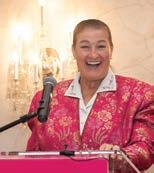
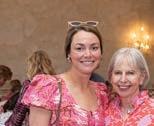

High Point Country Club May 7, 2025
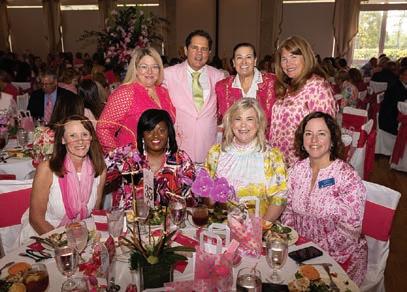
800-A Quaker Lane, High Point, NC 27262 (336) 886-5516 • www.hpfs.org
High Point Friends School is an independent school with a public purpose, rooted in Quaker values. A Friends education does not seek to inculcate a particular set of beliefs or doctrine; instead, it values the inherent worth and potential of each person.
Our Educational Vision:
• Create Scholars who think critically & solve problems
• Cultivate Community that is welcoming & inclusive
• Develop Leaders who are civically engaged citizens
• Practice Service Learning to enrich the lives of our students & community
Grades: Ages 2-8th grade
Admission Requirement: Applications accepted on a rolling basis. Contact admissions@hpfs.org for more information.
Cost of Attendance: $9,560 - $15,400 depending on grade level; HPFS offers financial assistance to those that qualify and accepts the NC Opportunity Scholarship
3310 Horse Pen Creek Road Greensboro, NC 27410 336.282.7044 • www.nobleknights.org
Focus: Noble Academy empowers students with learning differences to pursue their highest potential within a comprehensive, supportive educational environment.
Grades: 2 - 12 • Enrollment: 140 • Student/Faculty: 8/1
Admission Requirement: Average or above average intelligence, a dignosis of ADHD and/or a learning disability, including Central Auditory Processing Disorder and/or difficulties with one or more of the following: Attention, Processing speed or memory, Auditory processing, Executive functioning, Reading, Math, or Writing, and Academic fluency.
Tuition: $26,500 for all grades. Noble Academy can offer financial assistance to families that qualify. Noble Academy also accepts the Opportunity Scholarship and the ESA+.
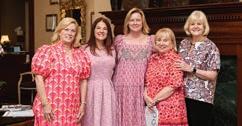



1128 New Garden Road, Greensboro, NC 27410 (preschool-grade 6) 12015 Pleasant Ridge Road, Greensboro, NC 27410 (grades 7-12) (336) 299-0964 • www.ngfs.org
The Triad’s only independent preschool through 12th grade school guided by Quaker faith and practice, and built upon the long-held standards of extraordinary Friends schools. NGFS was founded in 1971 with the goal of educating children from differing backgrounds together in a positive, affirming, and safe environment.
Misson:
Guided by Quaker values, New Garden Friends School is committed to being an inclusive educational community that honors and develops each person’s gifts.
Grades: Age 3-Grade 12 • Enrollment: 215
Admission Process: Families are encouraged to visit. Admission on a rolling basis. Application, report cards and/or transcripts, teacher and school recommendations, student visit, and essays for older students are required. For details, please see www.ngfs.org/admissions.
Tuition: $13,250-$27,250
1917 North Centennial Street, High Point, NC 27282 336.884.3333 • www.wcatrojans.org
Focus: Wesleyan Christian Academy is committed to shaping Christian leaders who will make a lasting impact for Christ today and in the future! In partnership with parents, Wesleyan provides a solid educational foundation rooted in biblical truth. We offer academic programs for high achievers and comprehensive support to help every student succeed. With unmatched student programming in athletics and the performing and fine arts, our graduates earn between $6.5 and $8.2 MM in merit-based scholarships yearly. Visit us and feel the difference!
Grades: TK - 12th Grade • Enrollment: 1064 • Student/Faculty: 21/1
Graduation Rate: 100%, with 90% of graduates headed to a four-year college/university
Admission Requirement: Early Application Deadline: Jan 16, 2026, but we accept applications throughout the year.
Tuition: $12,500 to $15,550
Schedule a visit or apply online at www.wcatrojans.org/admissions


May 8, 2025
Photographs by Peggy Hamilton

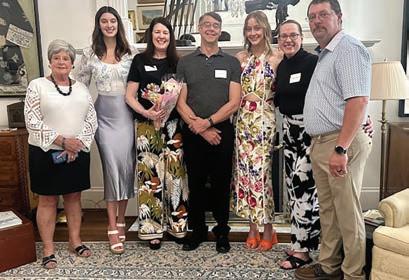
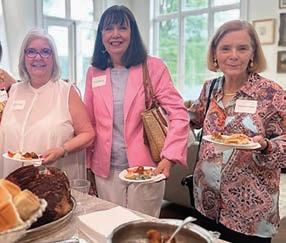

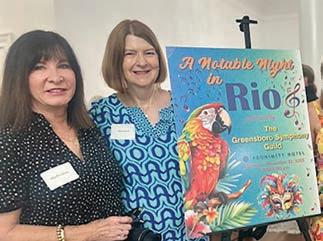


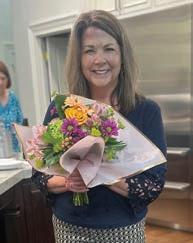


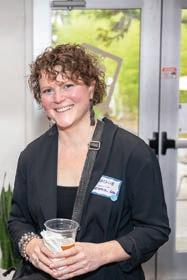
Artist Happy Hour
Back Table
June 10, 2025
Photographs by Devin Lane



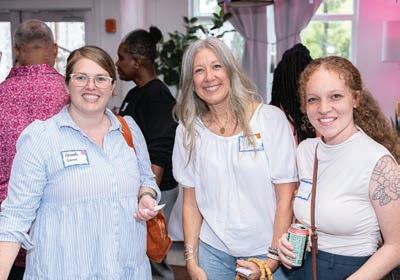

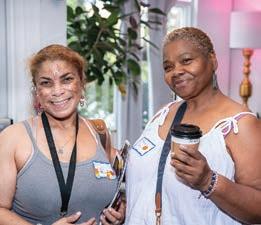


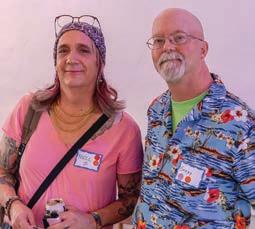
By Cynthia a dams
Some years ago, I bought a blue-eyed, Gerber-perfect baby boy. With molded blonde curls, an upturned nose, and wide eyes, his expression features bow-like lips, opened slightly, frozen in permanent surprise.
My baby is a cherubic-looking bust. Picture a 1950s-era doll head. He presides over my work life.
It soon struck me that those rosebud lips were parted just enough for a cigarette.
Which, I discovered, they handily accommodated.
The ciggie, a fake one I’ve used in a cigarette holder when I dressed as a flapper for a Halloween party, appears lighted. This took Gerber baby to another dimension. Unexpected. Unsettling.
There and then he became Bad Baby, official muse. Bad Baby, office mascot.
Bad Baby has presided over many false starts and rewrites. He sits right above my computer, where Bad Baby never fails to make me smile when I need it. An artist friend, Dana, was particularly delighted when she popped into my office and spotted Bad Baby, who is parked beside a primitive painted folk-art bus with “Guanajuato” scrawled on it.
The most compelling thing about the bus is the various clay figures of passengers. It’s difficult to say exactly what the crudely formed figures are doing, their arms raised in a gesture of helplessness, but it is appears they are trying to bail out. One figure stands on top of the hood and two on the roof, with others at the rear, appearing ready to leap into the unknown. I like the irony.
Who hasn’t felt like bailing? Who hasn’t had feet of clay? I identified with the hapless figures wanting to exit.
Dana has no shortage of creative projects. So, when I confessed to having a creative dry spell, she laughed.
“Blame it on Bad Baby,” she drawled. Problem solved!
Bad Baby as scapegoat.
Bad Baby is responsible for many things in my daily life. Typos. Missing the postal carrier when something needs to go out. Buying a greeting card and bungling the address.
Hangnails. Hangovers.
When my iPhone texts were hacked (something that Apple


aficionados suggest cannot happen), it didn’t occur to me to blame Bad Baby for the psycho-gibberish, disturbing rant, given he has no texting fingers.
The recipient, a good friend, believed I had actually sent them. He asked his colleague to find out what had so provoked me.
No, I assured her, I had sent no such messages. Yet there they were, on my phone.
Also embarrassing? Misspellings, poor grammatical construction, and lack of sense. Worse, too, that a friend would think that a writer sent something so garbled.
With red hot cheeks, I erased the texts (wouldn’t that make sense?), urged my friend to do the same, and dialed Apple support, immediately learning they needed the texts to trace the source.
Calls are spoofed. Seems texts are as well.
So, a few months later, I flinched when Dana reacted to a jokey text, responding that I was a filthy animal.
Was this real? Or had she also been hacked? Or had I been hacked again?
Shaken, I phoned her. She snorted, saying her text was merely a joke, a riff borrowed from the flick, Home Alone. Explaining how unnerved I’d been since the texting spoof, she snorted again.
“Blame it on Bad Baby,” my friend suggested again and laughed.
Just in case you’re wondering, Bad Baby is my invention. The OG. Turns out there is a 20-year-old rapper, Danielle Peskowitz Bregoli, who assumed the name Bhad Bhabie. I firmly believe my Bad Baby predates her Bhad Bhabie.
And I like old-school spellings far better. No phat bhabie nor brat bhabie for me. Just plain old, conventional, ciggie-puffing Bad Baby.
“You can be too old for a lot of things, but you’re never too old to be afraid,” seems apropos, another line borrowed from Home Alone. Some are frightened by dolls — an actual phobia called pediophobia.
An inexplicable text that appears to be from me but isn’t? That scares me.
And so, now I sit, scowling with narrowed eyes at Bad Baby, afraid to wonder just what havoc he might wreak next. But — if you should get a text rant from Bad Baby, please ignore it. OH


SCULPTED CABLE COLLECTION